#rwby alchemy
Text
Ruby and the Splendor Solis
Here comes a quick alchemy meta! Alchemy is an ancient practice, whose goal is to create the philosopher stone. This stone gives immortality, transmutes lead into gold and creates new life (homunculus). From a philosophical point of view, alchemy's aim is to nurture the spirit and to make it perfect.
As @hamliet has explained in several metas, RWBY is an alchemical story, which metaphorically illustrates the procedure to create the stone (RWBY/Ruby).
Today's post will explore Ruby and Maria's interaction in volume 6 episode 8 (Dead End):

As a matter of fact the scene references the 6th plate of the Splendor Solis.
WHAT IS THE SPLENDOR SOLIS?
The Splendor Solis is an alchemical text, which describes how to make the philosophical stone through 22 illustrated plates:
4 introductory plates present the protagonists of the alchemical journey
7 parables illustrate the alchemical death and rebirth
7 flask plates explore the alchemical process from a practical point of view
4 final plates describe the alchemical process from a spiritual point of view
How does Ruby and Maria's scene reference plate 6?
PLATE 6 AND VOLUME 6
Let's begin with describing what plate 6 is like:

This plate has three philosophers under a tree with golden fruits. The tree is a metaphor for the alchemical process as whole. It is the philosophical tree and if you climb it you reach the golden fruit (perfection/the philosopher stone).
The three people embody the phases of alchemy:
The young man climbing the ladder is nigredo (black)
The man who wears white outside and red inside is albedo (white)
The man who wears red outside and white inside is rubedo (red)
Citrinitas (the yellow stage) is instead symbolized by the yellow flowers and by the golden bough the men are pursuing. The scene as a whole represents a transformation, which is why the birds that fly in the sky have some green shades. Green is, thus, the color of transformation.
How does all of this rely to Ruby and Maria?
First of all, the two silver eyed warriors speak under a tree:

With golden fruits:

Secondly, this scene frames Maria as the teacher and Ruby as the student. Maria is initiating Ruby to very important knowledge, so that our young alchemist can continue her journey.
Ruby: I don't know… I don't know anything… What do I tell Jaune and his team when we don't even have a plan? Qrow's out drinking, Ozpin hasn't come back and even if he did, I don't know if I could trust him. And there's always Jinn, but… we only have one more question we can ask her. I feel like I'm letting everyone down…
Maria: If you're tired of not knowing anything, how about we discuss those eyes of yours?
MARIA, THE TEACHER
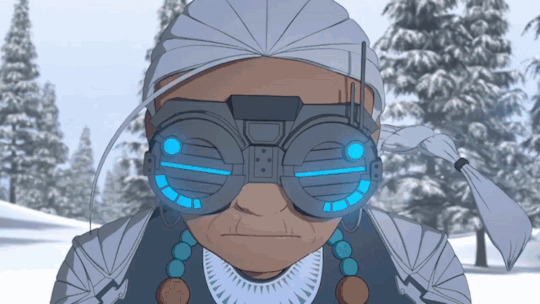
Maria embodies the archetype of the old wise woman. She is a mature version of Ruby (an older silver-eyed warrior), who comes in our protagonist's life to offer guidance. She is the more expert alchemist:

Maria grabs the golden fruit. Symbolically, this shows that she is far ahead of Ruby in the alchemical quest.
This is made clear by her:
semblance
weapon
Preflexes lets Maria sense everything better than others. Metaphorically, it means she has a better understanding of reality than others. This ties with her having wisdom.
Life and Death is made by two kamas that can be combined in a staff:
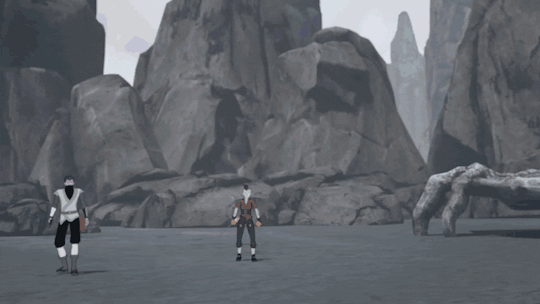
They can be separated (solvet) and united (coagula). Solvet and coagula is the mantra of alchemy, as this process aims to create the philosophical stone by separating and uniting the elements. Over and over. Until perfection is obtained. Metaphorically, it means a soul is refined through creation and destruction. Life and Death.
RUBY, THE STUDENT

Ruby is young and ignorant. She doesn't know what to do and she doesn't know about her eyes. She is the alchemist apprentice, who is going through a transformation:
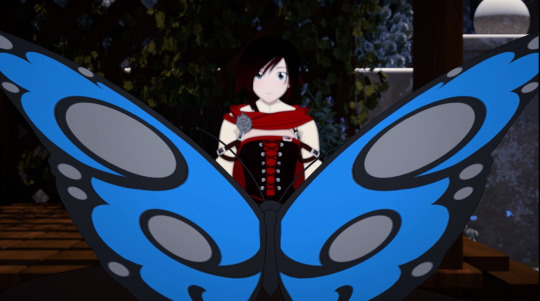
Differently from the Splendor Solis plate, there are no birds in the scene. However, the scenery is full of butterflies, which are another symbol of change. Of death and rebirth:

As far as the nature of Ruby's transformation is concerned, the setting gives us some hints, as Maria and Ruby are speaking in a garden full of white snow. That is because RWBY is approaching albedo (the white phase). In particular, volume 6 climax marks Ruby's passage from nigredo to albedo. This process if metaphorically foreshadowed in Ruby and Maria's conversation thanks to a specific visual cue:

Let's look at Maria's plate:
The grapes are purple/black = nigredo, the black phase
The plate is white = albedo, the white phase
The lemons/oranges are yellow = citrinitas, the yellow phase
The strawberries are red = rubedo, the red phase
The kiwis are green = transformation (plus prima materia, aka the beginning)
In short, the plate and fruits are a metaphor for the alchemical process as a whole. What's interesting is that a little butterfly flies on them:

It pauses for a little while on top of the grapes (nigredo) until Maria gently takes it and has it fly forward (towards albedo). The meaning is clear. Maria acts a mentor, who helps Ruby leave the black phase and enter the white one. She gives Ruby the knowledge she needs to face her "trial of fire":
Maria: The light will only work in the presence of Grimm. Meaning the only practice you'll get will be a trial by fire.
TRIALS BY FIRE
Ruby faces her trial by fire in the climax of volume 6, as she fights the Leviathan:

There she uses Maria's teaching and the relic of Knowledge to defeat her foe through her internal light. This moment is when Ruby and the group leave Mistral and the Black Phase once and for all. They are ready to face Atlas and the White Phase.
Still, this isn't the only trial by fire our Little Red Riding Hood has to go through. She struggles through a second one in volume 9, as she and the group leave the White Stage (Atlas) through the Yellow Stage (the Ever After), so that they can enter the Red Phase (Vacuo). Once again this passage is shown through the Splendor Solis.
There is a giant tree:

A wise woman:

Butterflies:
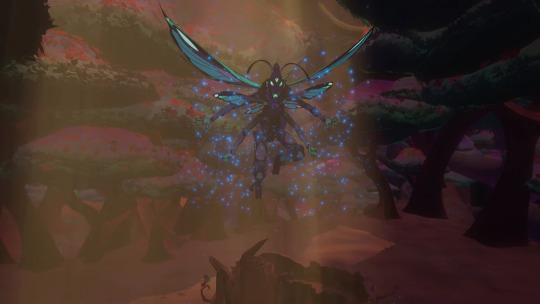

Once again, Ruby is given guided by an older and wiser woman under a tree. This time she has to make a choice to go through a transformation. A process of death and rebirth:

In volume 6 Ruby learns about her internal light, whereas in volume 9 she discovers her inner shadows. In volume 6 she is given knowledge, while in volume 9 she is offered a choice. At the same time, in volume 6 the Splendor Solis reference is focused on a single meaningful scene, while in volume 9 it is more pervasive and present throughout the entirety of the season. In volume 6 the Splendor Solis comments Ruby's journey (the microchosm). In volume 9 this alchemical texts conveys RWBY's adventure (the macrochosm).
However, this isn't the only difference between the two transformative trials.
IDEAL AND REAL
Volume 6 has Ruby become an ideal:

Volume 9 has Ruby grow into herself:
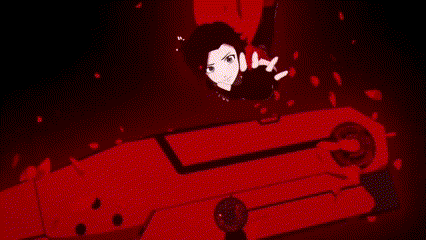
Similarly, in volume 6 she latches on an idealistic idea of Summer (the Huntress), whereas in volume 9 she accepts Summer as a person (the Mother):

This passage from ideal to real isn't something unique to our heroine's arc, but it ties to everyone's story. Here come two examples.
Jaune's arc
In volume 6 Jaune is inspired by Pyrhha to push forward no matter what:

He wants to become more like Pyrrha, his ideal self.
In volume 9 Jaune is taught by Weiss to stop and accept a loss:
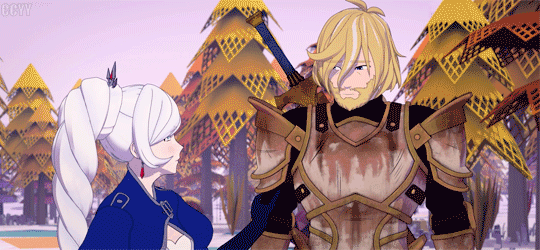
He realizes he is good as he is, despite his flaws.
Chemical weddings
In volume 6, Bumbleby goes through their second chemical wedding, where they kill Adam. The focus of Yang and Blake's relationship is that both girls have to become "worthy" of the other:
And now I know I'm worthy of you
(Oh can't you see, you could be with me)
With every smile you told me, "I love you"
(I am your dream, I love you)
They push each other to grow and to become their ideal selves. Yang has to overcome her anger and abandonement issues to stay with Blake. Blake has to stop running away to be by Yang's side. Their fight with Adam tests their progress on their respective flaws.
In volume 9, White Knight has their second chemical wedding, where Jaune dies and is reborn thanks to Weiss. Their bond is about letting go of childish fantasies (the charming prince and the beautiful princess) and to accept the other for who they are:
Weiss: I think you’re asking too much of yourself. We’ve been telling ourselves that failing means we’re no good. But I can guarantee even the best Huntsmen in history… they’ve all lost. But they were still incredibly brave… and good.
They let go of paragons and come to love their real selves with both strengths and flaws. Their conversation in front of the Genial Gems conveys exactly this.
Interestingly, Bumbleby and White Knight foil each other in another way, when it comes to alchemical symbolism.
Bumbleby focuses on death and separation. They represent the "solvet" part of the process.
White Knight is linked to rebirth and union. They explore the "coagula" part of the process.
To be clear, the solvet and coagula parts are present in both relationships. Yang and Blake go through destruction to come back stronger and more beautiful than ever. Similarly, Weiss and Jaune have to face death, so they can be reborn.
Still, the focus of BB's weddings is on death/destruction:
Adam cuts Yang's arm and impales Blake
Adam dies
Whereas WK's weddings climax in resurrection/creation:
Weiss is reborn
Jaune and Ruby are reborn
This is because the two relationships are complementary and illustrate different sides of the alchemical process. However, there is a third ship meant to embody both parts.
RUBY AND OSCAR = SOLVET AND COAGULA
Ruby and Oscar's wedding is kicked off by their first meeting, when Qrow (a bird) brings Oscar to Ruby and unites the Solar King and the Lunar Queen:

Ruby and Oscar's wedding references the imagery above.
It is a union of opposites. The scenery of their first scene together has Ruby marked as fire and air, whereas Oscar is associated with earth and water. Moreover, both the moon and sun are present.
In general, Ruby is moon, silver, red and air, while Oscar is sun, gold, green and earth. They complement each other and are perfectly balanced. So, they don't need a specific focus on neither death nor rebirth because theis arcs are gonna explore both the solvet and the coagula. They are the whole.
This complementarity shows also in Oscar paralleling Ruby during the trials of fire.
While Ruby is talking with Maria and going through an internal transformation, Oscar goes through an external transformation (he changes clothes). Ruby connects with Summer (coagula), while Oscar is free from Ozpin (solvet). Both their transformations are tested in volume 6 climax, where Ruby grows into a leader (macrochosm), whereas Oscar grows into himself (microchosm).
While Ruby struggles with herself in the Ever After, Oscar struggles with Ozpin in Vacuo. Ruby separates her perception of the self from Summer (solvet), whereas Oscar is merging with Ozpin (coagula). Ruby is in a fantastical world symbolic of the inside (microchosm). Oscar is in the real world, which is going through big changes (macrochosm).
Right now, Ruby and Oscar are bound to meet again through Raven (another bird), which might kick off their second alchemical wedding. Not only that, but Raven herself might play the part of the Nevermore, as she wears a Nevermore mask and her name alludes to The Raven, Poe's famous poem and the inspiration for the Nevermore Grimm. If so, this meeting might be Rosegarden nevermore wedding, which for RWBY ships is about overcoming grief and death through love. Another declination of solvet and coagula.
#rwby#ruby rose#oscar pine#rosegarden#white knight#bumbleby#whiteknight#rwby meta#rwby alchemy#my meta
63 notes
·
View notes
Note
I think that out of all team RWBY (including Oscar and Jaune), Yang is the weak link in terms of plot relevance and semblance/aura.
May you share your thoughts about this?
I don't know that I would consider her the weak link (I like her arc a lot, and I think she’s quite important to the overall plot), but I would consider Yang distinctly different. Particularly, her allusion is more symbolic and esoterically implemented than many of the others in RWB, but there may be a reason for that... but I'll leave that to the lovely and wise @aspoonofsugar to discuss.

I’ll talk alchemy instead and then move to plot/semblance :P
I’ve talked before about how Team RWBY are each linked to a particular stage of alchemy: Ruby to Rubedo, Weiss to Albedo, Blake the Blackening, Yang to Citrinitas. The order of the process is Black-->White-->Yellow-->Red. However, in alchemy yellow is subsumed into the red stage a lot of the time (hence why she's Ruby's half-sister), so it actually makes sense that she's a little different from her teammates in some ways.
I’ve also talked about how coding tends to work in alchemy (gender being “traditional” but obviously the least relevant):
Male: sulphur, red, heart, fire, air, gold, moon
Female: mercury, white, mind, water, earth, silver, sun
Plus, Ruby, Weiss, and Blake are all linked to the moon in terms of alchemy, as well as to silver, while Yang is the only one linked to the sun. This is emphasized from the very beginning, in each of their trailers. In terms of other alchemical principles, though, Yang and Ruby are both red, while Weiss and Blake are white; heart to Weiss and Blake’s minds, air and fire respectively to Weiss and Blake’s water and earth. So Yang is unique in some ways, but not as much in others. (Also, hey, Mercury is literally her opposite--hence, why they fight a couple times!)
I actually think Oscar and Jaune’s codings are just as unique, though. Jaune is the only one who’s transforming from his white/moon/silver coding to red/sun/gold, and Oscar, like Ruby, is mixed: he’s earth and water, which traditionally go with the moon and silver, but he’s gold and sun (Ruby’s air and fire should go with gold and sun, but instead she’s also silver and moon).
Plot + Semblance
I think Yang is just as linked to the plot as the others and more so than Jaune, actually! Her mother Raven is the spring maiden, and that’s not much different than Ruby’s link with Summer/silver eyes, Weiss with her father and the Schnee company, and Blake with her link to the White Fang. Oscar of course is Ozpin, but Jaune is just fighting his way into the story.
I am less talented at semblance analysis than Sugar-chan, again. I actually think Yang’s semblance is my absolute favorite, and one of the most relevant to the overall story’s themes . It symbolizes the risk all of them run throughout the story--that of choosing the quick, easy, violence-focused answer (which will ultimately just hurt them too) over the calmer answer that will ultimately heal. We can see this emphasized especially in Volume 5 (fitting because that’s kind of Yang’s volume where she confronts her mom and gets the relic), with the other arcs tying in symbolically. For example, Jaune goes for revenge and violence against Cinder, gets his friends hurt, and only then from his pain unlocks his semblance, which leads to healing. RWBY is gonna have plenty of cool fights, but the ultimate goal is to heal the world, not destroy all evil... because it’s literally immortal in the person of Salem.
27 notes
·
View notes
Text
Ozwen Family Portrait Redraw, 2022 vs. 2024
March 20th, 2022:

March 25th, 2024:
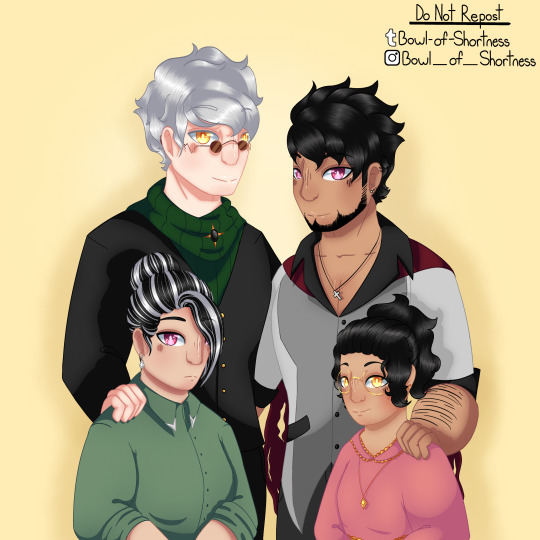
#alchemy draws#digital art#digital drawing#art#drawing#rwby#do not repost#remnant heirs au#oc#ozpin#qrow branwen#cloqwork#ozqrow#Qorbyn Branwen#Olivia Branwen#rwby legends scatter timeline
18 notes
·
View notes
Text
Why the Faunus storyline sucks ass: the personal/character level analysis
This is just my opinion, but to put in perspective how absolutely dogshit RWBY’s Faunus narrative truly is, I’m just gonna rant for a while and compare the storyline to another narrative that I think handled the topic of systematic racism and the cycle of violence due to racism very well: Full Metal Alchemist’s Scar and the Ishvalans.
Preface: The latter two do so well, in my opinion, because they never truly portray racism as a straight-up allegory in the premise of a fantasy world. By separating a fantasy narrative from completely writing it as a reflection of any specific civil rights movement, it becomes a universal message that everyone can understand and make connections themselves to real-life injustices without inaccurately and/or offensively portraying a sensitive topic such as racism like how RWBY did.
Extremely Long Post Below the Cut. Spoilers for RWBY, Full Metal Alchemist, and Full Metal Alchemist: Brotherhood.
Trigger warnings for: graphic character deaths, depictions/reference of character deaths, ethnic genocide, war crimes, mentions of abuse, racism, slavery, depiction of a hate crime (branding), reference to child slavery, mild gore, and depictions of violence.
We shall begin on a personal level, then perhaps move on to the systematic level of how these storylines are so different in the portrayal of racism in another post. Let’s start with the bad: Weiss Schnee and her racism against the Faunus.
I’m gonna be front with ya’ll here: I actually didn’t mind Weiss’ initial behavior at first; it’s obvious where they were going with her character and story: she started off as an entitled, racist and cruel person because of many factors in her life. Weiss came from the wealthiest family in Remnant, with a unique and versatile Semblance that can easily grant her a high status in Atlesian society, However, she is also from a broken and abusive household, with a neglectful mother and a father who was willing to put his heiress through a dangerous trial for her to leave to another nation to find her own path, which resulted in a permanent scarring on her face.

[A screenshot from RWBY White Trailer. Weiss Schnee in a dark room, eyes closed in a painful expression while blood trail down her face from a wound from the Armor Gigas]
However, Weiss has expressed quite vocal and malicious racism towards the Faunus, especially Sun during Volume 1 Chapter 15 “The Stray”

[RWBY Vol 1 Chapter 15 “The Stray”. Team RWBY gathers around an irate Weiss, who refers to Sun as a “riffraff” following his escape from authorities after stowing away on a ship.]

[RWBY Vol 1 Chapter 15 “The Stray”. Weiss holding up a caricature drawing of Sun Wukong to Penny, depicting him as a violent individual while referring to him as a “filthy Faunus”.]

[RWBY Vol 1 Chapter 15 “The Stray”. In response to Blake’s demand as to why she was degrading Sun for being a Faunus, Weiss gestures to a trashcan, insinuating that she equates him to being trash/referring to him as “filthy” due to his status as a Faunus]
Narratively speaking, these are condemnable behaviors for a character to possess, let alone one of the main characters of the show. Blake, another protagonist, even criticize Weiss for her racism and defended the Faunus, stating that people like Weiss and Cardin are the reasons why Faunus such as the White Fang have to resort to extreme measures to gain their rights.
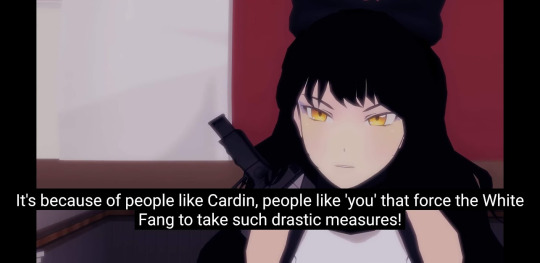
[RWBY Vol 1 Chapter 15 “The Stray”. Blake angrily declares that it’s people like Cardin and Weiss, in their discriminatory behavior, have caused the White Fang resorting to extreme measures in their civil rights movement]
So, narratively speaking, we should see that Weiss would reflect on her actions later on, and aim to remove herself from such toxic mindsets and redeem herself from her bigotry, right?

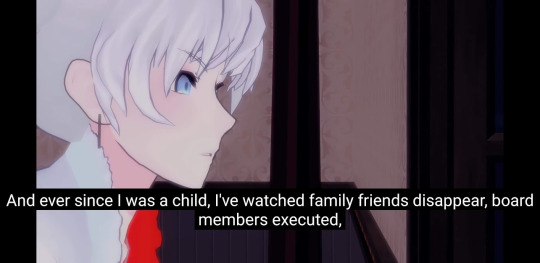
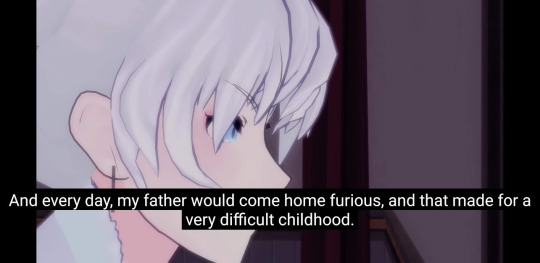
[RWBY Vol 1 Chapter 15 “The Stray”. In response to Blake’s anger, Weiss snapped back, declaring herself a victim in the ordeal with her family and the White Fang. She then recounts the deaths of the supporters of the SDC, the Dust robberies committed by the White Fang, and her father’s reaction, claiming that it had made her childhood difficult.]
Not even close.
Call me heartless, but while I’m not condoning Jacques’ abuse of his family, I find it insulting that Weiss would see herself as the victim over an entire race of people who are still enslaved by her family, and exploited by those same board members causing them to fight back.
Sun’s entire kingdom was drained of its resources by her grandfather and the Atlesian kingdom. Ilia, another member of the White Fang, lost her parents in Weiss’ family’s Dust mines after a collapse, then find herself without empathy from her human peers who mocked their deaths. Adam, who was another Faunus character, was enslaved and branded, permanently disabling him for life.
To compare their lives, knowing subjugation for the majority of it because of the way they were born, to Weiss’ is straight-up stupid. She’s a victim of abuse, but she also perpetuated the cycle of hate on a group of people who were still being used by her father, instead of placing the blame at Jacques’ feet.
What’s even worse? Weiss never apologized to Sun or Blake for being cruel to them in the show canon. You know what’s even more insulting?

[RWBY: The Official Manga Chapter 8 by Bunta Kinami. Weiss admits her wrongdoings, and apologizes to Blake.]
That apology was written in a secondary source material, by another author not directly associated with the main writing team at CRWBY. And guess what? This decision will never have any impact on Weiss’ canonical character or the main storyline. This is the same as fanfic, and we will never get that closure in canon.
Weiss then continued to not apologize, and in Volume 7 seemingly developed a “white savior complex” towards the Faunus racism in her own home kingdom. She told Blake that she wishes that she could “take back all the years of abuse her family committed against the Faunus”, but then went to a movie with Jaune and Oscar instead of a rally in support of a candidate running against her father in the Atlas council election, who was supposedly pro-Faunus.
Why? Why not have both of them be at this event? Sure, it went to shit, but to show the audience that Weiss has truly changed and Blake wanted to continue to fight for Faunus’ rights, it’s logical to have them go to this rally right?? No, Weiss went to a movie with a guy she dislikes, and Blake went to a club with a team she doesn’t like. Neither of them took initiative to actually change the systematic racism against Faunus in Atlas, the infamously most racist kingdom in Remnant.
Matter of fact, Weiss and Blake rarely have any development with this conflict between them save for sparse moments that don’t amount to anything and came out of no organic progression at all. They never talk about the ongoing discrimination anymore, Blake blamed her own kind for the way they were treated and placed the responsibility of Adam’s White Fang at their feet, and Weiss never truly did anything to change the Atlesian people’s mindset on the Faunus citizens there. Hell, Marrow, the token Faunus in the most elite unit of the Atlas military, never has another conversation with them about what it’s like being a Faunus in Atlas. It all went to waste.
Now, let’s compare that to FMA

[Full Metal Alchemist. A young Scar faces his people during the Ishval Civil War]
The character Scar is a fascinating one; he’s a survivor of the Ishvalan people who were massacred by the Amestrian government and their State Alchemists to create a philosopher stone (a great form of alchemic power) in exchange for their lives following torturous experiments.
Scar also lost his brother in the war, who before passing away gave Scar his own arm tattooed with a transmutation array as a legacy. Understandably, Scar was enraged by this chain of events and went on a killing spree to eliminate every State Alchemist as revenge for what they did in the war, even if they weren’t involved at all.
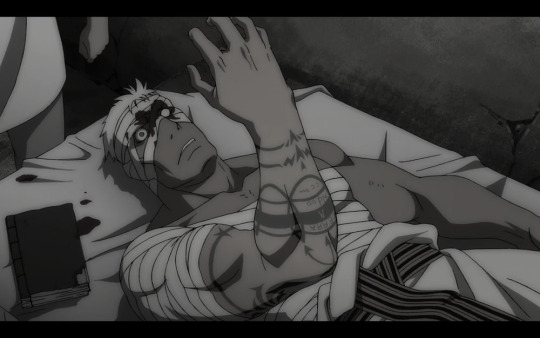
[Full Metal Alchemist. A heavily injured Scar awoke to see that his arm has been replaced with his brother’s, who died in the war. His face was twisted in an expression of horror and shock at the revelation.]
But perhaps one of the most interesting differences between Scar’s story from Blake’s, and even to the rest of the Faunus storyline, was that even though Scar’s actions were extreme and he himself acknowledged it with great guilt, especially after murdering a doctor couple who did nothing but saves innocents in his grief, FMA’s narrative never invalidates or demonized his anger.
Scar was allowed to be angry, to be hateful, to be in emotional pain after a traumatic event in his life without the narrative ever condemning such emotions. The narrative never fully condones his rampant extremism either, especially after the murder of Winry’s parents and orphaning their young daughter in his grief. And despite all of this, Scar was given more to his character than just a man consumed by wrath and blood.

[Full Metal Alchemist. Scar places his hand on the amalgamation that was Nina Tucker and her dog Alexander, with the intent of mercy killing them after they were forcibly fused by Shou Tucker, Nina’s father, and a State Alchemist.]
Scar exhibits mercy, sadness, understanding, and empathy towards other characters throughout the series. He was allowed to be a fully fleshed-out character, with more than just the drive for vengeance and the need to destroy out of fury. And once again, he fully acknowledges that his actions were wrongful and do not excuse himself for killing innocents such as the Rockbells. And this is where another important character in his story comes in: Winry Rockbell, the orphaned daughter of his first victims.

[Full Metal Alchemist. Scar was surrounded by the Elric brothers while Winry Rockbell aims a gun at him, racked with grief after learning that he was her parents’ murderer.]
When face to face with Winry, Scar never blamed her for hating him. He fully understood her pain and told her that he wouldn’t stop her from trying to shoot him out of vengeance for what he did to her parents. But he claims that he would not just let her, because he has a mission to complete, just like she does.
But then, Scar’s entire ideology was flipped on its head after this sequence of events:

[Full Metal Alchemist. Scar aimed to attack Edward Elric, who threw himself in front of Winry Rockbell to protect her. Scar was reminded of how his own brother protected him and hesitated.]

[Full Metal Alchemist. Winry approaches a bleeding Scar after he told her that she can enact her vengeance. However, Winry surprises everyone by offering to bandage up his wound, claiming that he would bleed to death if he doesn’t tend to it.]
Scar was shown an alternative to end the cycle of violence from the girl who he had wronged, altering his previous mindset of only stopping the cycle by completely destroying a side in the conflict. Winry, instead of continuing it out of retribution like he did, chose mercy and compassion. But at the same time, she refuses to forgive him for the atrocities he had committed.
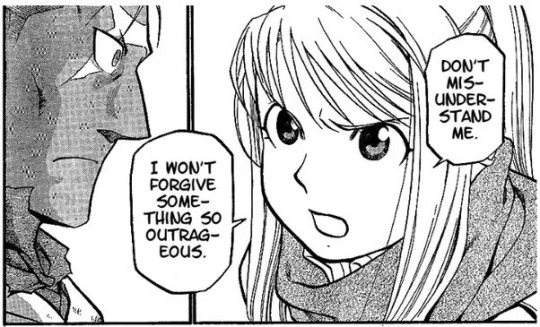
[Full Metal Alchemist. Winry declares that while she doesn’t want to kill Scar, he should not misunderstand her actions as forgiveness.]
Compare this to how the characters in RWBY reacted to this sort of conflict; an in-universe minority acted with extreme measures against an oppressive and murderous system, causing them to commit atrocities against innocents that affected another important character in the narrative in major ways.
What FMA did right was not invalidating either Scar or Winry’s pain and anger, the narrative of FMA never condemned Scar for fighting back for his people, the narrative never judges Winry for not forgiving him, the narrative of FMA did not sacrifice either of their characters to progress the plot and the conflict.
RWBY did not do anything like that. Blake lost all of the sparks that marked her as an interesting character, who aimed to fight for her people’s rights and calls out bigoted actions, even when it came from her teammates and someone who she will see as a friend. Weiss never apologized to the Faunus she had hurt, nor did she substantially change anything about the way she or her fellow Atlesians think about the Faunus. Weiss did not add anything to Blake’s story, and she never even met the greatest sin her family has committed that we, the audience, saw on screen.

[RWBY Volume 6 Chapter 11 “The Lady in the Shoe”. Adam Taurus with his signature White Fang mask off, revealing a branding scar across his left eye spelling the initials “SDC”, permanently disfiguring and disabling him.]
Weiss never saw Adam.
Adam, arguably the character who underwent the most racial abuse at the hands of humans, at the hands of WEISS’ FAMILY LEGACY, was made into a caricature of an abuser. Despite the fact that this proves that he was a slave, the fact that her family continues to exploit an entire race of people and treated them like property or dirt, despite all of the possibilities of these characters having more to them.
Weiss never saw what her family’s name has done to Adam. And Adam himself was made into someone the audience hated, instead of having the respect he deserved. The respect that Scar had.
His anger was demonized, even by Blake who knows he has this brand on him, his fury was condemned by the narrative and the characters in said narrative (Ghira, Blake, and Sienna), and his trauma was mocked by the writers when Miles motherfucking Luna referred to his torture as “grab a branding iron and let him have it”.
And the conclusion to these two narratives cannot be more different. Scar, having gained the knowledge of what truly happened to his people, aimed his anger at the one who was deserving of it the most. King Bradley, better known as the Homunculus Wrath, was the ruler of Amestris and the one who ordered the massacre of the Ishvalan people.

[Full Metal Alchemist. Scar, using the arm with the Construction array, delivers a fatal blow to the Homunculus Wrath.]
This outcome was both narratively and symbolically satisfying for Scar’s story, as well as the Ishvalan narrative. Wrath was the one who spearheaded the ethnic genocide of Scar’s people, creating a seemingly endless cycle of violence and pain, giving birth to the man known as “Scar” who was willing to throw himself into hell to enact vengeance for his people.
But Scar defeated him after altering his view on the cycle of violence, no longer just depending on mindless destruction but to truly changing for the better while never compromising on his righteous fury for his kin. But he aimed it at someone who deserved it, instead of innocents. And it started with a girl who showed him another way to live with grief. To move on.
So he killed the Homunculus named Wrath and symbolically separated himself from that version of the wrath inside of him. Scar the Ishvalan got the respect he deserved as a character, and subsequently his story, the story of the Ishvalan the fantasy race who underwent horrific treatments that we the audience can see happening in our own real-life history, was given that respect it deserved.
What did Adam Taurus, the civil rights fighter and the child slave, have in his story’s conclusion?

[RWBY Volume 6 Chapter 12 “Seeing Red”. Adam Taurus was stabbed by Blake Belladonna and Yang Xiao Long during their conflict with the severed halves of Gambol Shroud, Blake’s weapon.]
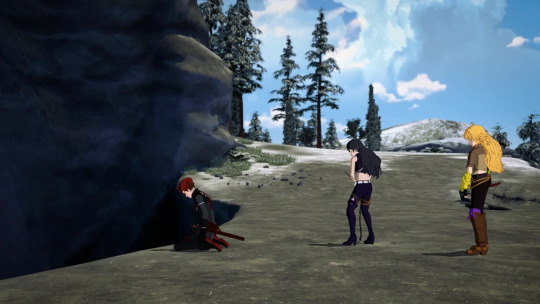
[RWBY Volume 6 Chapter 12 “Seeing Red”. Adam Taurus collapsed onto his knees before the waterfall’s mouth, while Blake Belladonna and Yang Xiao Long watches him.]
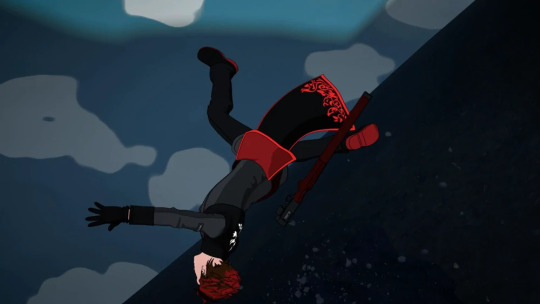
[RWBY Volume 6 Chapter 12 “Seeing Red”. Adam Taurus succumbed to his injuries and fall into the basin to his death.]
This.
This is what Adam was given as a conclusion. Let it speak for itself. And let it speak for what RWBY truly sees about a racism storyline that the writing crew chose to write in their narrative. The narrative that they themselves claimed to be a direct allegory to the African-American civil rights movement in the U.S. during the late 60s-70s.
This is what RWBY gave to their narrative of a racism plotline.
#pathi's personal thoughts#long post#rwde#rwby critical#full metal alchemist#full metal alchemis brotherhood#adam taurus critical#weiss schnee critical#blake belladonna critical#yang xiao long critical#abuse tw#abuse mention /#abuse /#Faunus Racism#tw/racism#racism mention /#racism /#violence /#violence tw#racism tw#death tw#death /#my longest post yet#but I got a lot of rage on this shit#so imma just put it all here#just go read FMA guys it's worth it#anti rooster teeth#anti miles luna#anti mk#anti crwby
71 notes
·
View notes
Text

Eira Ozpin (Aka Young Ozpin)
Figured I’d draw my boy so here you go
Please don’t repost :)
81 notes
·
View notes
Note
Guys guys we already have a good uncle for Jaune...and it's this man!!!

HOHO! I already made a short story on it, but man would that be a good pick!
---------------------------------------------------
Here's a link to that story, since y'all asked.
#rwby#jaune's family#my thoughts#alex louis armstrong#full metal alchemis brotherhood#fullmetal alchemist#my answers
35 notes
·
View notes
Text

Ed and Yang being pals!
#drawing#fanart#art#art tag#fullmetal alchemist#full metal alchemist#full metal alchemis brotherhood#edward elric#ed elric#yang xiao long#rwby#rwby fanart#fma#fma brotherhood#fmab#fma fanart
11 notes
·
View notes
Text
Slightly Unhinged (879 Words)
Deep in the bowls of Beacon's labyrinth like basement, Jaune toiled away. It had been a couple of weeks since he "vanished" and while others worried and searched for him, he became a shadow. Stalking the halls after hours, nicking the items he required to do his work, to achieve his goal.
The promises of elixirs that would promote strength, agility, intelligence, vitality and vigor. It was the answer to his problems... the magic bullet that would allow him to close the chasm between himself and his peers.
/=/
Ozpin: So, still no sign of Mr Arc?
Glynda: None.
Ozpin: Have we reached out to the VPD, just in case he has gone to Vale?
Glynda : I don't feel that is necessary at this stage, considering the reports I have been getting from various members of the staff.
Ozpin: What types of reports?
Glynda: The kitchen staff are reporting missing food and drink items. They figure it's a single student raiding their larders, do to the small amounts that have gone missing.
Glynda took a glance down at her tablet to confirm some information before continuing.
Glynda: Professor Peach is also reporting missing items. Some limited quantities of dust, but more puzzling are the old chemistry and dust mixing equipment, plus some of her stocks of rare flora samples.
Ozpin: So, we have a single student missing, but also minor quantities of supplies being taken.
Ozpin leaned forward on his desk, his hands clasped underneath his chin.
Ozpin: So, if my assumption is correct, you feel Mr Arc is still on beacon’s grounds, and is helping himself to various items around the school, correct?
Glynda: I do. I understand the food stuffs, but the other items are slightly confusing.
Ozpin: I agree. What about his scroll? Have we been able to ping it?
Glynda: No. I refuse to believe that he knows how to disable the tracking software, so the only reasonable conclusion is, he’s keeping it turned off.
Ozpin: Anything further?
Glynda: Aside from the interviews conducted with the remainder of team JNPR, which you have already reviewed. Nothing.
Glynda sucked on her bottom lip for a minute, before speaking up.
Glynda: I think you made a serious mistake, Ozpin, in regard to accepting someone so ill prepared to be here.
Ozpin: Why do you say that?
Glynda: Not even considering his grades, there is the single fact of his fraudulent transcripts…
Ozpin: He passed initiation.
Glynda: Barely and only because Ms Nikos took a liking to him from their first interaction.
Glynda reached up to push her glasses up her nose.
Glynda: Though, I will admit, that he showed remarkable fortitude and ability when it came to directing others; which is supported by his leadership grades. But he wasn’t ready, and I feel the mental strain has caught up with him.
Ozpin: I see.
Ozpin leaned back in his chair
Ozpin: So you feel Mr Arc is having a mental breakdown?
Glynda: I do.
Ozpin: It’s a valid theory, but I feel, no I know, there is something else happening.
Ozpin reached up and rubbed his chin, as if in deep thought.
Ozpin: Has the review of his actions leading up to his disappearance been completed?
Glynda: Yes.
Ozpin: Highlights?
Glynda: Nothing much. Mr Winchester was abusing Jaune’s insecurities, his team interactions were strained; however there is his checking out of three books from the library almost three weeks ago. Books that have yet to be returned.
Ozpin: What were the topics?
Glynda: Alchemy, and a couple of resource books focused on identification of flora and fauna.
Ozpin: Alchemy?
Glynda: Yes. Le traité d'Ophélie sur la propriété alchimique.
Glydna frowned as she saw Ozpin’s whole body stiffen.
Glynda: Ozpin, do you know that book?
Ozpin: (sighing) You could say that. I wrote it, a few hundred years ago, and placed the only remaining copy in the stacks.
Glynda: Then it appears that Mr Arc has found it. Is this a problem?
Ozpin: Do you have a list of the items Professor Peach is missing?
Glynda said nothing, but instead pulled up a file on her tablet and handed the whole device to the Headmaster. It took him only a few minutes to review the list.
Ozpin: Cancel all classes. I want every teacher to start searching Beacon’s basement. We need to find Mr Arc like yesterday!
Glynda: Is it that serious?
Ozpin: Yes. Yes, it is. None of the recipes in that stupid book were designed with thought towards interactions with aura awakened individuals. I wrote it with the intention that its recipes would be used to assist the average person’s life…
Ozpin’s face was drawn and pale, as he dropped the tablet on his desk while rising from his seat.
Ozpin: I… I tested some of them on the aura awakened…
Glynda: Ozpin?
Glynda questioned as Ozpin looked to be shaking, while moving to grab his cane and head for the elevator.
Ozpin: Aura negatively interacts with the products. It corrupts and twists the end results. Mr Arc is in grave danger… if he is still at Beacon as the evidence suggests, the only place he could be hiding out is the basement.
Glynda: I’ll inform all the staff.
Ozpin : I just hope we’re not too late.
#rwby#jaune arc#female!jaune#alchemy#henshin#Slightly Unhinged#YEP... he's writing ANOTHER genderbent Jaune fic...
9 notes
·
View notes
Text
I say this as someone who lurked in the trenches cross-sites since Volume 1. I know. people. are never. happy.
#I even remember people being upset during volume 2#people want to rewrite history that the entitlement of this fandom is some altruistically-motivated hatred on Monty's part of just because#the show got 'bad' during volume 3#because they committed to decisions set up prior to that volume#sorry I think you are probably fucked in the head if you think the writers of this show are only doing it for clout/to 'corrupt'#a pure vision#the alchemy/monomyth/jung is embedded in red/white/black/yellow; that was always there#the jung has always been there#the fundamental ideas to the story have always been there#you can only tell this sort of story (ultimate sympathy for salem) with this storytelling structure#anyway I think there is a blight in the RWBY fandom#it's like nothing else#I've definitely spectated my fair share of delusional fandoms#but this one gets particularly weird
8 notes
·
View notes
Text


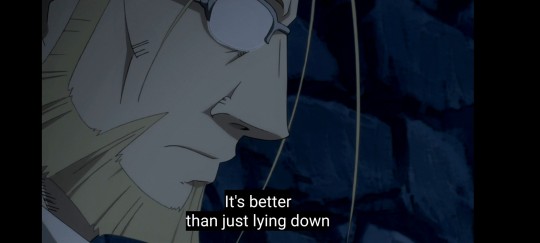

Funny. I've been saying that exact thing about ozmas war with Salam almost ever since we learned she was immortal...
3 notes
·
View notes
Text
Yu-Gi-Oh GX and Alchemy: The Nigredo

So Yu-Gi-Oh GX is the first successful Yu-Gi-Oh spinoff after the original manga and anime ended, and it began two trends, one a long line of anime spinoffs that would continue to make anime original stories revolving around the trading card game and two that each new anime would focus on a new method of special summoning.
When creating an all new Yu-Gi-Oh story with only some input from the original mangaka, Hikokubo Masashiro stated GX focusing on fusion summons was an idea the staff came up with. Hikokubo felt that polymerization and fusion summoning were rarely used during the duel monsters era, and felt that it was a very underutilized but incredibly interesting mechanic that was unique to Yu-Gi-Oh! When he proposed the idea to have the new summoning be fusion focused, Takahashi loved the idea and was extremely enthused by it.
Now the question before we even begin is why am I analyzing Yu-Gi-Oh? It's because it's a shonen anime and this is the blog where we overanalyze shonen.
Yu-Gi-Oh is literally no different from any anime with a power system, it's like Hunter x Hunter except instead of using an ovceromplicated nen system with a lot of rules, the characters instead play an overcomplicated card game with a lot of rules. The same way a character's nen is thematic and telling of their character in Hunter x Hunter, their cards and dueling style is thematic to them in Yu-Gi-Oh! If you can just get over the fact that it's kind of silly everyone's using cards to fight, it's the same as any other shonen anime. They're all using magic cards to fight each other with magic, the cards are a power system, and the power system means something in regards to the characters in a shonen anime.
By Yu-Gi-Oh GX using fusion as its focus summoning method (combining two or more monsters to summon one) it's also thematically about alchemy - specifically physical alchemy solve et Cogaula. Latin for dissolve and coagulate, the process in which through four elemental stage silver is refined into gold and a philosopher stone is created.
The main character of Yu-Gi-Oh GX is also on a journey to become an alchemist, and create the philosopher's stone / the elixirof life. He is also a duelist who uses an archetype known as the "elemental heroes" that fuses heroes based off the four elements (fire, earth, water, air) and also yin and yang (light and darkness) into different combinations to create stronger monster. A character who's strongest card at the end of the first season is called "Elemental HERO Elixir" and requires featherman (wind), burst lady (fire), clayman (earth), and bubbleman (water) to fuse together in order to summon. A character who's art depicts a man wearing gold armor surrounded by the four elements of the Yu-Gi-Oh cardgame in the background.

However, that's only in season 1 and Judai's journey stretches for four seasons. I only used elixir as an example to show that fusion and the elemental hero archetypes are both things that connect Judai to alchemy, and why his journey is to complete the four stages of alchemy and the creation of the philosopher's stone.
I'm also making this post for Kate who is the only person that will read it that Yu Gi Oh GX incorporates Alchemy research as well as A Song of Ice and Fire and RWBY. Because just as with those shows the formula of "Solve et coagula" is stuck to, though Yu Gi Oh GX uses "Fusion" as its main metaphor for dissolve et coagula.
Anyway, Yu Gi Oh GX has four seasons, with four main story arcs which follow the four stages of Alchemy to a T.
The Seven Star Saga: Nigredo
Society of Light Saga: Albedo
Dimmension World Saga (Citrinitas)
Darkness Saga: Rubedo (Red)
These four stages also proceed in order of four elements, which as I said is the same as the four elements of monster cards in Yu Gi Oh.
Fire
Water
Earth
Air
They also all correspond to four colors as long as we're getting the basics out of the way, because color symbolism is important to aclhemy too. These are:
Nigredo / Black
Abledo / White
Cintrinitas / Yellow
Rubedo / Red
For more proof that Alchemy is baked into the DNA of this show, here's a group shot of what are basically the main characters for opening two, and look what colors they are wearing.

Judai - Red / Black
Fubuki Tenjoin and Asuka Tenjoin - White
Manjoume - Black
Sho, Misawa, Kenzan - Yellow
There's also three main dorms Osiris red, Ra Yellow, Obelisk Blue and yes Obelisk Blue is Blue but the uniforms are Blue and White and they're even replaced by the white dorm in the second season. Characters even change what colors they are wearing to indicate progression in their arc, Fubuki is introduced to us as Darkness possessed by his inner darkness and then switches to an all-white uniform by season 2 nigredo -> albedo. Manjoume sheds his blue uniform for Black and stays in the Osiris Red dorm for three seasons after losing his elitism -> entering the nigerdo stage.
Most importanly though Judai our alchemist is the only character to wear red and black, as Red is the color of the philosopher's stone which is Judai's main goal but Judai like Manjoume also wears black underneath to signifiy he too is going through the nigredo stage. Judai is an alchemist attempting the great work of self, and he must start at stage one - Nigredo.
So, to begin with what is Nigredo?
The Alchemy of Darkness - Nigredo
In alchemy, nigredo, or blackness means putrefacation or decomposition. Many alchemist believe that as a first step in the pathway to the philosopher's stone all alehmical ingredients need to be cleansed and cooked into a uniform black mater. This is sometimes called "blacker than the blackest black>" Nigredo means putrefecation and decomposition.
It's ruled by the planet Saturn and connected to lead, which is ocnsidered to be the basest and most impure metal. Metaphysically, it is tied to the dragon and the destruction of the dragon, symbolized by decapitation and the skull of the raven.
This is an unpleasant and often violent process, because one must face one's darkest flaws. Because one 'reaps what ones sows" and noen gains likel only to what one loses accoring to the Laws of Isis spoken by the Angel Amnael, to change into a final nature one must destroy its flaws - and thus its whole property - so that it might be remade again. In a lab one must cook all components down to a uniform black matter, which takes no less than fourty days - or one year of high school.
Judai begins his journey wearing inverted colors, black school uniform on the outside and red on the inside. He also is marked in the first episode and season 2 as the Fool. Saio a character with the ability to see the future who plays a tarot themed deck, sees Judai as the fool, the wildcard in which fate can change.
The fool's journey, and the process of alchemy are similiar, they're both things Jung references for the development of the self. Tarot is season 2 territory so all you need to know right now is Judai is the fool in both senses of the word, he is at once innocent and ignorant. His innocence inspires people, and his ignorance causes problems, though that won't be highlighted until season 3. The fool is on a journey to gain wisdom, which is why Judai's first action in the anime is meeting up with a magician (Yugi, who's ace card is the black magician) who gives him guidance by giving him winged kuriboh.

The story of the Tarot is actually a paralel to the alchemist's journey, and the Fool--who begins his trek untouched by the world around him because he sees and understands nothing--is the fledgling alchemist, with his powers and potentials all untapped and unknown. This is a childlike figure in many ways, and the symbolism here is capable of being both that of innocent oblivion and the callous disregard that children (and Judai) are also so capable of. In fact Judai's entire character revolves around the dual faces of the fool, that innocence and ignorance can be the same thing, and that jUdai may not mean harm in his ignorance but that doesn't mean it's not harmful and his ignorance is why he needs to go on a quest for knowledge in the first place.
And Yu-Gi-Oh GX is primarily about Judai's journey. There are other characters who grow up besides Judai, but it is primarily about Judai going on a journey from childhood into adulthood. I will be mentioning other characters here, but when they change it's usually meant to reflect Judai in a way too.
Either way, Judai's role as the alchemist is indicated right away in his first duel, as he uses flame wingman - his favorite card a fusion monster that is specifically a fusion between man (featherman) and woman (burst lady) in order to cook crowler's antique gear soldier which is made of metal. This not only sets up the formula for how he'll win every major duel in the show, fuse weaker monsters into stronger mosnters. It also serves as some early, early foreshadowing for the appearance of the Rebis the fusion of man and woman that happens in the final stage of alchemy. The Rebis in this case being Yubel but that's season 3 territory.
Flame Wingmna's appearance is foreshadowing for Yubel, it's also pretty clearly a Rebis, it's a fusion of a featherman and burst lady, and it also has a dragon head appearaing on one of its arms. It's also the first succesful fusion / attempt at alchemy we see Judai perform in the show and it's what lets him win his first duel. It even appears in front of the moon because Judai played Skyscraper, switching the time in the duel from night to day.


However, alchemy doesn't just happen once. It's a process of continual refinement where the alchemist dissolves and coagulates over and over again in order to purify himself, the same way that Judai's entire sidedeck is countless different attempted fusions of his elemental hero monsters, each fusion serving a purpose in a different situation.
Chemical weddings, the union of opposite elements don't happen once in this show but over and over again. This is important to point out for all three seasons to show how much alchemy symbolism happens in this show and how much alchemy is a continual process.
The Stages of Alchemy
However, before continuing forward I need to say Yu Gi Oh GX is a pretty weirdly paced show, the first 100 episodes or so are setup for a dark deconstruction that happens in the next 90 after that. So Season 1 and Season 2 are both a lot of set up for both changes and alchemical processes that will happen mainly in Seasons 3 and 4. Which as I said, chemical weddings happen multiple times not just once and alchemy may have stages but it's not necessarily a strictly linear process. The series however does still follow the 4-part structure of alchemy and even makes specific references to medieval paintings which describe the alchemical processes.
There are also several allusions to the Splendor Solis - 22 illustrated plates which describe the alchemical process [source]
Which are divided into 4 groups like this:
4 introductory plates - they present the protagonists of the alchemical journey.
7 Parables - they describe the alchemical death and rebirth
7 flaks plates - they describe the alchemical process from a practical point of view
4 final plates - they describe the alchemical process from a spiritual point of view.
Seasons 1 and 2 being one long introduction for the second half of the anime, both include references to the four introductory plates. We'll be covering references to those two as we continue our journey into season 1.
I bring this up now because in episode 3 we are already at our first reference to Splendor Solis, Plate 4 the meeting of the king and the queen, the male and female, the yin and yang, the sun and the moon. The opposition of two equally matched forces, what most call the chemical wedding.

Judai and Asuka in the third episode duel each other over water with both of thme standing on boats. Asuka is the queen of the obelisk blues called that by several characters, and Judai not only quickly becomes the best male duelist in the school he's also on his journey to being a king in season 3. Judai's flame wingman (fire) actually clashes with her Cyber Blader (ice) during the duel atop the water.

Asuka primarily wears white, which is associated with Abledo. She is also associated with water and ice (she uses an ice deck when brainwashed by sartorius in season 2). In Jungian symbolism, the Albedo stage of alchemy is also tied to the union of anima and animus. There will be more time to cover this in my season 2 meta, but just as a starter Asuka in this episode is basically set up to be a female Judai, something compounded upon later in the season.
The basic premise of this episode is that Cronos puts a fake love note from Asuka to Judai in order to try luring Judai into a trap to visit the girl's dorm at night. When Sho gets lured by the trap, Asuka thinking very much like Judai does, doesn't see a potential romantic partner but a potential duel rival.
Asuka's true love isn't boys, but dueling itself much like Judai who for the first two seasons seems either oblivious or weirded out by women showing affection for him and who's primary method of making friends and connecting to people is by dueling others.
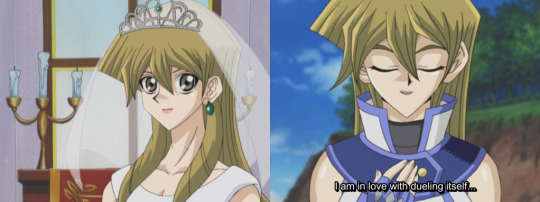
Judai and Asuka's first meeting isn't necessarily a romantic chemical wedding, because one happens in season 3 and it's with someone who's not Asuka - but it is still a union of opposites. Anima and Animus is something I plan to cover more in season 2 but basically Jung divides the psyche into two part, the feminine aspects of personality and the masculine aspects and makes the observation that most men aren't accustomed to their feminine side and vice versa. Men must therefore come into touch with their feminine side and integrate their feminine traits into their everyday life in order to become fully realized people.
Judai is basically dueling with the female version of himself, another person who loves dueling above everything else and uses it as a way of conencting with other,s and Asuka even pulls a Judai-like move, she threatens to get Judai and Sho expelled to extort a duel out of Judai because she wanted to size him up as a potential dueling rival.
Asuka also plays the role of the high priestess in the fool's journey, to Yugi's magician. As it's through his encounter with Asuka that Judai gains passive guidance for what his role will be in season 1 - as she's the one actively looking for her brother Fubuki which will lead Judai to the seven stars plotline. In fact, while Judai came to the anbadoned dorm because him and Sho were sharing scary stories, he sticks around and explores it deeper specifically because he heard Asuka make a mention that her brother went missing there.

This leads to the introduction of shadow duels - duels where characters bet their souls on the line and the consequence for losing is being consumed by darkness, otherwords a failure in alchemy.
The entirety of season one is basically one long pattern of Judai who only duels for fun and to connect to other people learning that there are darker sides to dueling (shadow games) and going through one long process of realizing that not everything is for fun and there are times you duel with your life on the line. Or at least, that's what he should be doing but a lot of Judai's development is stalled until season 3. However, that stage is still set up here.
Judai does not really grow a lot in season one, but we have other characters going through their own mini-alchemeical journeys in order to reflect Judai. For instance, each season Judai has a rival / foil that contests with him for the hero role. In season 1 it's Manjoume who thinks he's the one more set up to inherit the next king of games.
Manjoume goes through a pretty common arc for shonen characters. He's suddenly defeated by the appearance of a new rival, he loses all confidence in himself, he goes off somewhere else to train and then returns to defeat the rival that knocked him off his pedestal.
However, that usually happens to protagonists. Manjoume, a rival character, goes through more of a journey than the main character of his own show at least in season 1. Manjoume follows the nigredo formula pretty much to a T.
We see Manjoume break down completely. He loses to Judai even after getting cards from Crowler (his Dragon card is even killed by Judai) he then has a mental breakdown and tries to cheat against Misawa only to lose again and leave the school entirely. Even his deck goes through the process of dissolve and coagulate, as he has to get rid of his old deck and then find 40 new cards in the northern tundra and put together a new deck from scratch. He even returns to Duel Academy wearing black and purple after having gone through the process of breaking down entirely and reforming to signify his change in the nigredo stage.
This is the kind of arc and internal struggles you give your main character so we find their growth and journey compelling, but Judai's basically already a dueling prodigy he doesn't need to become stronger as a duelist. In fact Manojoume's internal insecurities are more at focus in this arc than the main character's too.

Judai is usually the character who duels the main boss, but in season 1 and 2 he rarely if ever feels the pressure to win the same way that Manjoume does in just this one duel with relatively little stakes. In fact if alchemy especially nigredo requires boiling and pressure in order to change the chemical composition of the metal that they're currently boiling, Manjoume is more emblematic of that chemical change -> heat and pressure allowing him to metamorphosize into a new person.

In fact Judai purposefully doesn't talk to Manjoume during this scene because he doesn't feel like there's anything he could say on an emotional level that would help him b/c Judai isn't really mature enough to understand that feeling of responsibility and pressure Manjoume is struggling under - he just tries to work it out in a duel instead.
Season 1 is all about Nigredo, about plunging into darkness but Manjoume who plunges into darkness to find himself and to an extent Asuka who journeys into the darkness to find her brother are the oens who actually experience a change while Judai remains a mostly static character. He is the impetus of change for both of these characters, but he doesn't really change himself just yet.
So Asuka has an exernal objective -> find Fubuki, and Manjoume has an internal flaw -> His insecurity and inferiority complex and both of them need to plunge into darkness in order to remedy these things. Judai doesn't have any objective at all, but because he comes into contact with Asuka and Manjoume he helps Asuka with her quest and Manjoume with his internal insecurity.
From early on Judai despite literaly fighting with a deck called the "Elemental Heroes" is more of a designated hero, then an actual hero. As I pointed out above other characters struggle with the kind of insecurities that protagonists usually struggle with. Judai doesn't need to learn to believe in himself or be a better duelist, he's already a dueling prodigy, that's Sho, and Manjoume's struggles. Asuka is the one who has a personal motivation to save someone because she wants to save her brother, Judai only helps because he wants to help Asuka. Judai is picked to fight once the seven stars start appearing not because he is the most heroic character, but because he is the best duelist.
It's not that Judai doesn't help when someone asks him for a helping hand. He always gives his help when asked for it, but otherwise he's an incredibly passive character who continually "only duels for fun" even when the stakes get higher. He only feels the pressure to win that Manjoume did for one episode after the gauntlet of Darkness Camula and even then it's immediately resolved with a duel against Kaibaman.
However, despite not having the things usual main character have, an outward objective, or an obvious internal flaw that he needs to fix or boil away in the alchemy sense he's still the central character of the show. Fubuki is Asuka's brother, and yet when he appears again it's Judai who duels him.
Yami no Game - Versus Darkness
The first instance of actual plot in this show happens in episode 29 (Yu Gi Oh is a well paced show / sarcasm) when Fubuki / Darkness appears as a member of the seven stars, to challenge Judai for his key, kidnapping his friends and holding them hostage in a volcano for an ante. This entire duel is steeped with alchemy symbolism and is to be honest one of my favorite in the series. It's also Judai's first real "yami no game" if one counts the duel at the dorm and the duel against Jinzo as warmups.
To recap from above, Nigredo is the first step of alchemy, it's usually associated with fire, the color black, and the death of a dragon. This duel takes place in a volcano. A volcano where dragons made of flame rise up from the lava, and Judai's opponent Darkness walks right out of the fire to face him.
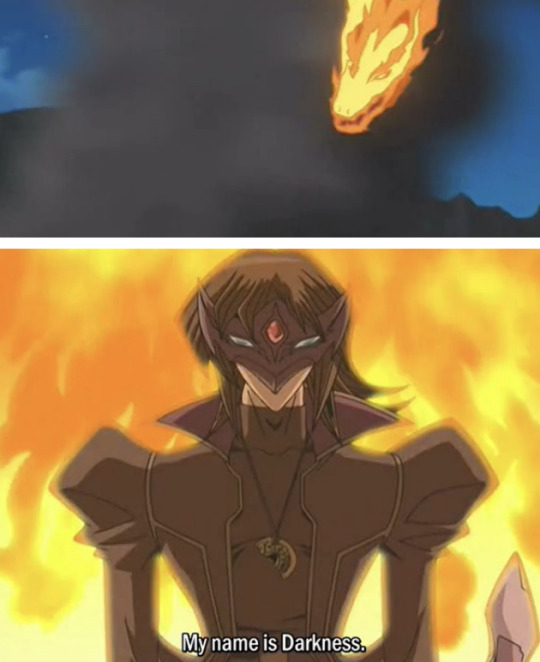
Darkness not only hits all the symbols for the first stage of alchemy, his deck also corresponds to this stage. He's running a red eyes black dragon deck, a deck who's ace monster "Red-Eyes Darkness Dragon" gets stronger for every single monster in your graveyard. If Nigredo is initiated by the death of a dragon. They fight on what is basically a graveyard of dragons with dragon spirits constantly jumping out of the lava, the dead spirits empowering Red Eyes Darkness Dragon even further.
Red Eyes Darkness Dragon - Cannot be Normal Summoned/Set. Must be Special Summoned (from your hand) by Tributing 1 "Red-Eyes Black Dragon". Gains 300 ATK for each Dragon monster in your GY.
Fubuki arrives in practically a storm of fire, promising to melt everything away if Judai doesn't take things seriously. He even calls Judai half-hearted for not realizing what is at stake here. Once again he's applying heat and pressure to try to force a transformation inside of Judai.
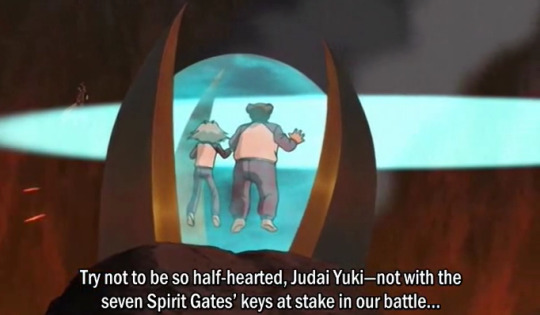
It is the first and last time for awhile someone challenges Judai seriously on this level (as most of the seven star matches bar Camula get kind of silly after this) but it also incorporates the Nigredo and the Work of Self, 'if you cannot overcome the blackness and despair of your own self, you will be burned away'. The volcano, the dragon graveyard, red eyes darkness dragon all incorporate the image of the skull, the dragon and the fire which reduces one to black matter.
In a normal narrative this is where Judai would succumb to the pressure like Manjoume did and start to take things seriously, but once again Yu Gi Oh Gx is building up a three season long-con. The one who changes isn't Judai, but rather Fubuki who's internal darkness is purified by the end and we see him return to his usual self, though he'll call upon the darkness again in season 2 and then season 4 because purification isn't' a one and done process.
We're shown other characters around Judai changing, and Judai often being the impetus for that change, but we're not shown exactly why until all the way in episode 45 when Amnael decides to play his hand, because Yu-Gi-Oh Gx is a well paced show (sarcasm).
If we focus on the duels that develop Judai as a character it goes a little something like:
1st duel against crowler establishes his use of fusion
1st duel against asuka - chemical wedding / anima + animus
1st duel against zane - establishes relationship with sho
3 duels against Manjoume - Manjoume's arc
Judai vs Misawa - More for Misawa's arc because it teaches him that isntinct can win against obsessive thinking over strategy.
Judai's 3 shadow duels (vs Titan, vs. Jinzo, vs. the Gravekeepers)
Finally, vs. Darkness / Fubuki
The only duels that really are about Judai as a character are Yami no Games, the ones where Judai is forced to bet his life on the line in a duel because those are the duels that challenge his philosophy that dueling is just for fun and his desire to duel purely for his own entertainment. Basically every other duel that Judai gets into up until this point is for other characters not him, only the Yami no Games int true Nigredo fashion push Judai's arc along as he slowly realizes there are times where he needs to carry responsibility and weight on his shoulders and keep going.
When the pressure of dueling becomes too much for him after Darkness and Camula he does receive an alchemcial bath, in the form of a hotsprings episode where he gets to fight Kaibaman in a low stakes duel which relieves him of the pressure temporarily. Kaibaman is also dressed in white, and plays the blue eyes white dargon the counterpart to the red eyes black dragon.
The impetus for this episode is a dream where Judai sees himself losing against an unknown shadowy dragon, which causes both of his friends to burn away in fire while he's consumed by the darkness as a price for losing the yami no game.

In those last minutes too Judai's more concerned with his friends who are crying out for his help then he is for the fact that he himself is being consumed by the darkness. Something which will come back in season 3, because Seasons 1 and 2 are excellent at setup and foreshadowing if nothing else.
Foreshadowing because there is a scene where Judai's friends do burn away and he does sink into darkness, his nigrido and all his anxieties reflected in this dream here prove true but once again it happens in season 3.
Things that seem like they are neatly resolved in seasons 1 and 2 will always be called back to in Season 3. Judai goes through several mini arcs of "I need to take dueling more seriously" only to revert back to his usual carefree irresponsible attitude, because in seasons 1 and 2 the consequences for Judai not taking thing seriously and messing up aren't as severe as they'll eventually be.
Judai is called to in his Yami no Games plunge the depths of his own personal darkness, Daitokuji leads him to three shadow games to make him realize there are games where real life people can get hurt - Fubuki yells at the top of his lungs not to half-ass this duel or his friends will burn away into nothing. Judai is called to explore those depths of darkness... he just doesn't. Manjoume does, Fubuki does, Asuka does, even Sho and Ryo have an honest conversation about their relationship as brothers when Camula holds Sho hostage so Ryo will lose the duel.
I'd argue there are hints that Judai does have an inner darkness that he's refusing to examine all the way back in season 1 too, because the foreshadowing in this show is excellent. In episode 5 when they're all sharing ghost stories, Judai shares a story about how he thought he could hear the voices of his duel monsters when he was asleep.

Only for Judai to jokingly end the horror story by declaring that he didn't see a thing.

Those who have watched season 3 know that this is a bald-faced lie, because it was right around that age that Judai was given a haunted card by his father that put all of his friends into comas and made it so no one wanted to duel with him let alone be around him. Judai used to be able to see card spirits, until the traumatic incident of one dark card spirit made him cut off his ability to see them entirely. Judai tells Sho half the story, and then blows the rest off as a joke.
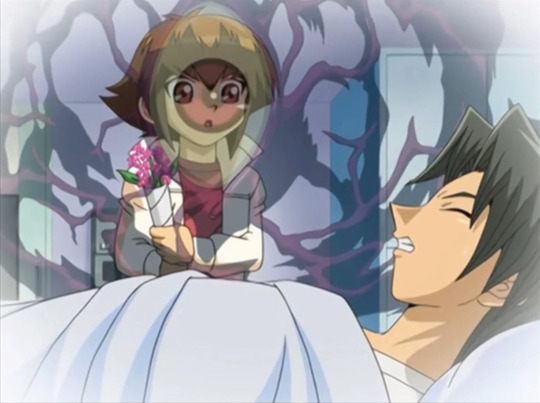
This scene is pretty clear season 3 foreshadowing, but also in a sense of alchemy, Judai is failing to confront the darkness here because he remains ignorant of his repressed childhood memory. He muses for a second on the fact that he can remember hearing card spirits when he was younger, but doesn't reflect on why he stopped hearing them because he's coping poorly with that traumatic childhood incident still. Which is why he is so stagnant because even when he's given opportunities too - he doesn't reflect on his past, or even reflect on who he is whatsoever.
This small detail of his backstory doesn't come until season 3 so technically I'm spoiling you, we're given no information at all in season 1 why Judai loves dueling so much and why it seems to be the only thing he cares about not because the writing is bad but because Judai himself never reflects on those things.
As Judai plunged into the world of Yami no Games, he could have reflected more seriously on these things, but he didn't because Judai is also more concerned with other people, and forced to duel to save other people first before himself.
Judai fails to commit nigredo, and this normally would result in reverse alchemy or even character stagnation but that doesn't happen until season 3 - mainly because in season 1 Judai has a mentor to sweep in and kind of fix his mistakes for him.
There's a whole bunch of duels in between this, but really Judai's next plot relevant duel is episode 44 the Seventh Shadow. When Daitokuji goes missing the gang goes out searching for him, only to find that he's facing Daitokuji as the alchemist Amnael and the sevenths star.
There's a billion alchemy references in this duel, because as I said Judai has only three really plot important alchemy duels this season the first being darkness, the second amnael, and the third Kagemaru and so all the symbolism is frontloaded into this one.
First off, Daitokuji carries around an emerald tablet for a millenium item gifted to him by Kagemaru and he also uses this symbol - which resembles the alchemy symbol for the sun, but also a traditional depiction of an ouroboros a snake eating itself.


The ouroboros a symbol that appeared in alcehmy in Graeco-roman egypt, the same era that the Amneal Story appears from. A symbol which ties to the sun, mercurius (hermes) and his caducous staff which contained a male and female snake interlaced.
In Egypt the sun went on a journey to the underworld every night, only to come back to the world of the living every morning. In the duel itself, Daitokuji is long dead, and Judai must in a way kill his mentor as apprentice in order to replace him as alchemist. Daitokuji also comes right back immediately as a ghost, because life and death are an eternal cycle like the ouroboros itself.
Daitokuji goes by the name of Amnael an angel who appeared before Isis to reveal the great mystery to her. Amnael becomes a lover to Isis and reveals the secret to her, but first makes her swear a mighty oath by "fire and water, like and darkness, by fire, water, air, and earth" and a variety of Greek and Egyptian Deities.
The great secret in question:
“So go then, my child, to a certain laborer named Achaab, and ask him what he has sown and what he has harvested, and you will learn from him that the man who sows wheat also harvests wheat, and the man who sows barley also harvests barley. For a nature rejoices another nature, and a nature conquers another nature.”
In other words the great secret of alchemy is that you reap what you sew. In other words alchemy, like chemical reactions is all about actions and consequences.
This also ties to the phrase "as above, so below" which is chanted constantly in the two episode duel against Daitokuji. A phrase which is on the emerald tablet, (borrowing this from Kate). The emerald tablet is also wielded by hermes, so once again, greco-roman / egyptian alchemy lore.
"That which is above is like to that which is below, and that which is below is like to that which is above."
Things in the macrocrosm are mirrored in the microcosm, or in other words BE THE CHANGE YOU WANT TO BE IN THE WORLD. You have to change yourself before you can change others. The personal change that an alchemist goes through in acquiring the philosopher's stone and finishing a chemical wedding will radiate out to the rest of the world.
This is the role that the master alchemist gives to his apprentice.
Amnael and Judai's duel is basically a crash course of alchemy for dummies. Amnael's card archetype the Alchemy Beasts uses a distillation to summon seven different alchemy beasts which resembles the seven step process of alchemy.
Aretos the time
Ekanos the Mercury
Leon the Lead
Moonface the Silver
Ouoroboros the Bronze
Salamandra the Steel
Golden Homonculus
Coincidentally the number seven shows up a lot this season. The seven stars are the duelists that the main characters have to face in yami no games, probably a reference to the fact that there are seven heavenly bodies in the ancient medieval world, saturn, jupite,r mars, venus, mercury, moon, and sun which also correspond with the seven steps of refining metal into gold listed above. Sun being gold, and again sun being associated with Judai.
While also using support spell cards that reference the nigrido, albedo and rubedo. Before finally using the Macro-cosmos card... which is again covered above changes on the microscale effect the macroscale.
All in the world originates from a single substance altered in various ways to form heaven and earth. Even the world of man known as the microcosmos and the world of the heavens known as the macrocosmos.
So, humans and outerspace are connected?
Amnael then procees to push the sun through three phases, helios - the primordial sun, Helios - Duo Megistus, and Helios - tris magestius. The second stage being a reference to this.

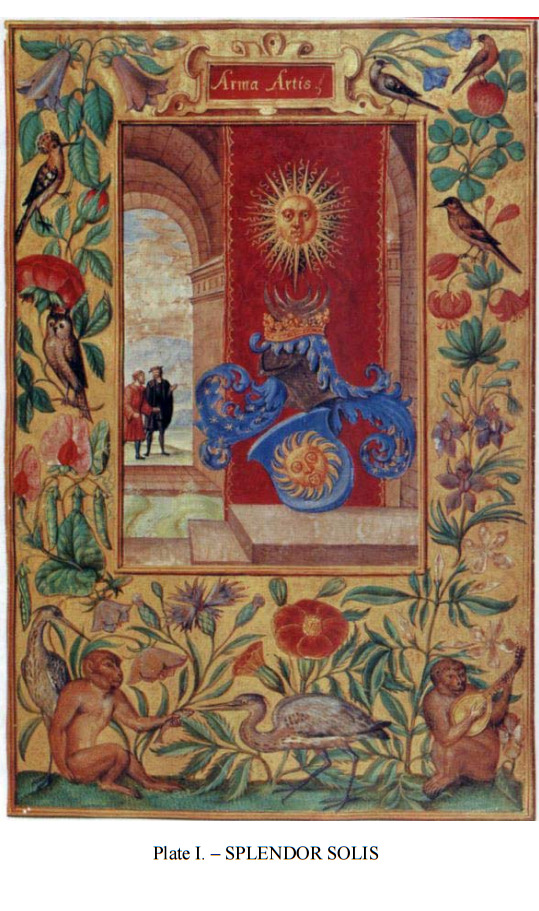
Outside the building where this standard is housed are two men. Their body postures might suggest they are teacher and initiate. The master points to the standard, separated from them by swirling and overflowing waters. There is also a three-step platform leading up to the standard, possibly reflective of the tria prima which all alchemical substances are made from; Paracelsus defined these as Mercury (Spirit), Salt (Body), and Sulfur (Soul)
The master is teaching the student - there are two men, two suns, ad even two babboons in this piece. Sharing and art. Giving and taking. The teacher shares, and the student takes, indicative of the fact this is Daitokuji's final lesson.
In alchemy three suns also appear to show the three stages of aclehmy, the blakckun, white, sun and red sun. The black sun is considered important for the dissolution stage of alchemy. The man holding the flask contianing the golden liquid, made from the four elementsor rather Plate 2 is also referenced in this duel.


Daitokuji is the old man with the flask, the duel also concludes with an elixir created from the four elements of nature. Judai creates elemetal hero elixir by fusing four elemental heroes of different elements in his graveyard. After her reflects upon what he's gained in the past year at Duel Acamdey compared to what he didn't have before - friends.
At which finally Daitokuji elucidates why he chose Judai of all people as his chosen pupil.
"Alchemy 's ability to change all into gold is merely a superficial phenomenon. It's true aim is to change the hearts of people into purer, nobler things."
Judai as we'll find out in season 3 started out the story as a friendless loser, and his desire to connect to others through dueling, causes him to purify the people around him by enduring many trials and tribulations for their sakes.
Amnael is also the first to notice the potential of Judai, and that this potential lies within Judai's darkness. Though, even though Judai is pushed to do a little self reflection in this duel (admitting to himself that he was lonely before he came to duel academy and this is the first time in his life he's had friends) he doesn't actually look inside that darkness towards those repressed childhood memories we were looking at earlier.
If anything while Daitokuji's lesson is a short-term fix, like a bandage over Judai, it doesn't actually help him in the long-run. This is because the reason why Judai is succesful in this season is not really anything of Judai's doing, but because Daitokuji the master rigs it for him. Daitokuji is the one who prepares challenges to increase Judai's strength at dueling, Daitokuji is the one who hands Judai the emerald tablet that lets him make a philosopher's stone during his duel with Kagemaru, Daitokuji is the architect of most of the plot in season 1 and Judai just kind of passively follow his script. Judai is not the alchemist in the first season, he's the apprentice and basically he only makes his first step in his journey by consuming his master and that's in episode 45, when the season is 4/5ths of the way over.
Judai is the alchemist, he's supposed to change others by forming relationships with them the same way that he can fuse two monsters together to form a stronger monster. However, he also has to change himself in order for that to happen and Judai doesn't change through seasons 1 and 2 - he gets by in the short term but it costs him long term development.
Because the duels Judai gets into are always about other people and not about himself. Even the climactic duel of the season against Kagemaru, Judai barely knows who this guy is. Judai's not there by choice, Judai is there because Daitokuji set things up so that his student Judai would defeat Kagemaru the main villain.
Judai's not dueling for himself so we barely learn anything from these duels, and Judai still doesn't really take this duel seriously. The one small thing we get from him is this:

"I feel sorry for you, you can control all the powerful monsters you want, but if you're the one wiping out duel monsters... no one is going to see you as a friend. And that'd make you lonely right? Live as long as you want, but without friends around, it'd just be boring right?"
Which sounds like a pretty shallow statement, but is telling of Judai. Judai had no friends before coming to Duel Academy. Judai gained friends because he was a strong duelist, Sho looks up to him because he's a dueling prodigy like Ryo, Asuka befriended him as a duel rival first, Manjoume only views him as a rival, Ryo sees Judai as someone who's potential for growth surpasses him because Ryo being a perfectionist feels like his perfectionism is stagnant. Judai's only way to connect with people is through duel monsters, and the reason most of these people have an interest in him is because he's a dueling prodigy. Thus, Judai equates dueling with making friends, and believes he has to keep getting into duels like this for the sake of his friends rather than himself.
Judai only wants to duel for fun, but is put into situations where he has to duel with high stakes, because everyone relies on him as the best duelist around, and because he thinks the only reason he made friends in the first place is his skill as a duelist.
Thus, Judai even when forced into these stressful duels, will fall back on his whole "I'm just trying to have fun" thing in order to cope because he's not really here because he wants to but because other people have put him into this situation. Therefore, he doubles down on his own personal enjoyment to convince himself he's here because he wants to and so the pressure doesn't get to him the way he's seen it get to other people like Manjoume.
Judai goes through several trials that seem like Nigredo in season 1. He goes through yami no duels where his life are on the line, challenging his philosophy of only dueling thrilling opponents for fun. He's put through literal trial by fire twice, first by Darkness, then by Daitokuji, situations where he will literally burn away into ash if he doesn't perform. He even duels a Yami no Game with Kagemaru where he forges a philoopsher's stone to create 3 custom cards to win the duel - but once again that's not really Judai who forged it because Daitokuji did it for him.
Daitokuji argues that the true alchemy changes the hearts of other people into nobler, purer things which Judai has arguably done for his friends - but what about his own heart?
Other people around Judai change, and are changed by Judai, but Judai himself for the first two seasons does not change. Even in incredibly plot important duels, and I'm including season 2 as well, because in both cases Kagemaru and Saio Judai wasn't really facing himslf or even a reflection of himself. Kagemaru is Daitokuji's enemy and mess to clean up he passed onto Judai, and Saio is Edo's chilhood best friend who became a victim to the light of destruciton. In both cases Judai swept in to fix things because that's what Judai does, he fights others battles for them because he himself lacks either an internal or external reason to duel - and he doubts his abiltiy to make friends if he didn't go around fixing everyone's problems.
As Above, So Below
It is other characters who go through a Nigrido phase in Season 1. However - their Nigrido phases will be reflected in Season 3. These characters experiencing their own inner turmoils mirror the obstacles that Judai has to face ahead of him.
Asuka
Season 1: Judai helps Asuka searching for her brother who's disappeared into the darkness.
vs.
Season 3: Judai travels into another dimmension to find Johan after he disappears from this world, only to find he's possessed the same way Fubuki is. Judai also blames himself for Johan's disappearance and takes on the burden to save him entrely by himself, like how Asuka leads the search for her brother.

Manjoume
Season 1: Manjoume is completely crushed by his responsibility to always win that his brother's force onto his shoulders.
vs.
Season 3: Judai being told to his face he wont' be able to win because he doesn't carry any burdens or serious responsibilities, because that's what drives people to try hard when they're pushed into a corner. Only for Johan to tell Judai that much like Manjoume is being pressured by both of his brothers, Judai has always had to carry everyone's hopes on his shoulders. When he cant carry them anymore, he has a breakdown that pretty much mirrors Manjoume's season one breakdown word for word.
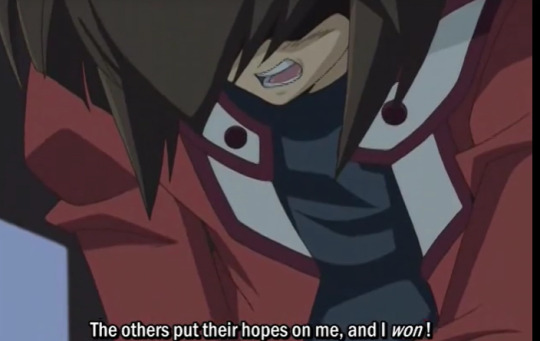
But, even then I won. The others hope their hopes on me, and I won! But still...!! They're all gone. There really was something missing within me. But what is it? What was missing?
Sho
In season one: Judai basically becomes the replacement for Sho's brother, who he has a poor relationship with and Sho has to face his inferiority complex towards his brother head on.
vs.
In season three: Shoe becomes the trigger for Judai's growth when he rejects Judai entirely and stops calling him "aniki" being the last one to abandon him in the dark world when just about everything goes wrong.

But, I guess I thought wrong. Big bro you've just been dueling to satisfiy yourself. You're not my big bro (aniki). You're not my big bro (aniki).
Fubuki
Judai even becomes lost and faces his inner darkness like Fubuki does, the first person to appear before Judai and challenge him to a Yami no Game. Fubuki who was possessed by a dark version of himself who valued power above everything else and then got lost in that darkness.
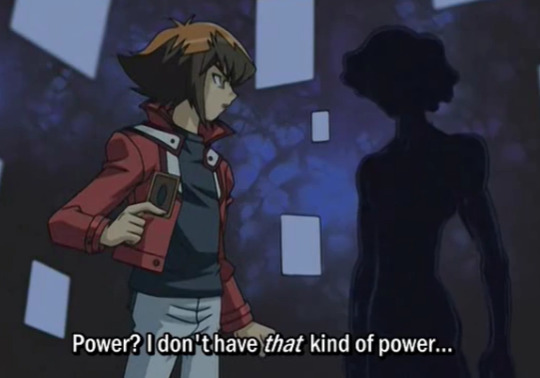
Judai has no arc in season one, and instead helps other characters along in their arcs. However, Judai's inability to change himself or confront his own inner darkness bites him when two seasons later.
Judai's arc then reflects aspects of all of their arcs. Sho's afraid that his brother doesn't love or respect him because he's an inferior duelist to Ryo. Judai loses Sho's love and respect. Asuka has to go on a journey into a darkness to find her loved one and fears Fubuki may never return. Judai repeats that same journey for Johan. Manjoume's cracks under the pressure his brothers put onto him to always win because his family's love is very conditional. Judai finally cracks when he realizes a lot of his friendship was built on the very conditional fact that he had to always win duels for them and fight for other people's hopes and dreams and not his own. In season one Judai cleanses Fubuki's inner darkness, in season 3 Judai sinks into his own inner darkness that's been there and ignored all along, and so on.
The nigredo phase is about cleansing your own impurities, and Judai is presented to us like a pure shonen hero who doesn't need to be cleansed so he spends his entire time cleansing other people - only for it to turn out his heart turned out to be darker and more selfish than anyone expected.
#ygo gx#yu gi oh gx#yu gi oh#judai yuki#alchemy#this took all day#and i still have like another one to write#ygx meta#ygo meta
38 notes
·
View notes
Text
Chemical Weddings: White Knight
Here it comes my second short meta on RWBY's chemical weddings. It is White Knight's turn! Feel free to skip the introduction, if you have already read it in my previous post (or if you already know what a chemical wedding is)
WHAT IS A CHEMICAL WEDDING?
A chemical wedding is a motif used in alchemical stories (aka stories, with symbols related to alchemy). It is a metaphorical union between characters and it represents two opposites coming together. Think of it as a motif that comments on a relationship and describes how it changes throughout a narrative. It shows how two characters' bond develops and how they integrate qualities of each other. Even if it is called "wedding", the union doesn't necessarily have to be romantic, but often it is. Like in RWBY's case.
RWBY uses chemical weddings to develop romantic relationships. How does the series do it? This meta by @hamliet explains it perfectly:
It uses some alchemical imagery (like plates from alchemical texts as reference)
It employs elemental motifs (water, fire, air and earth), which are keys to alchemy
It integrates other symbolism, like romantic subtext or fairy tale references
Both hamliet and I have already talked about RWBY ships and chemical weddings, so this short meta is just a quick review of White Knight’s ones, with some integrations.
Here are Whiteknight's posts, that I am going to reference:
Weiss and Jaune's foiling throughout the series
White Knight and Arkos (+ Whiterose)
White Knight's scenes in volume 9
White Knight's chemical wedding 2.0 by hamliet
Now, let's dig into White Knight's two (for now) weddings.
WHITE KNIGHT'S WEDDINGS
White Knight's weddings make use of this imagery:

There is a Mercurius (entity representative of change), who unites a man and a woman through impaling one of the two.
This is what happens to Weiss and Jaune twice:
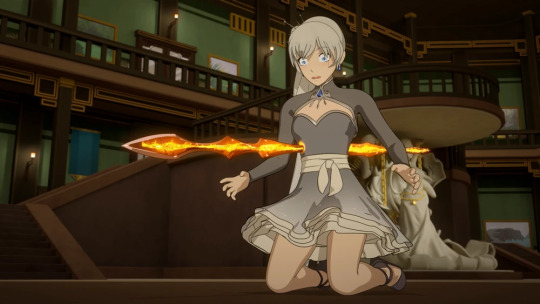
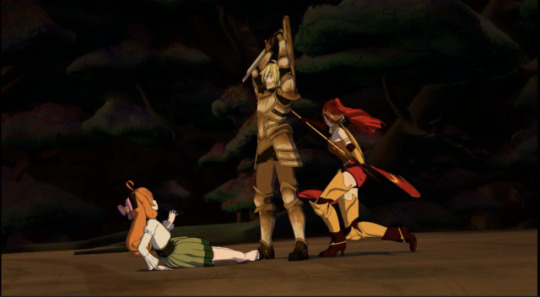
In Mistral Cinder impales Weiss and in the Ever After the Curious Cat impales Jaune. Not only that, but both Cinder and the Cat make sure Weiss and Jaune indirectly hurt each other.
Cinder takes Jaune's heroic remarks and uses them as an excuse to mortally wound Weiss:

The Cat tricks Weiss into physically hitting Jaune:
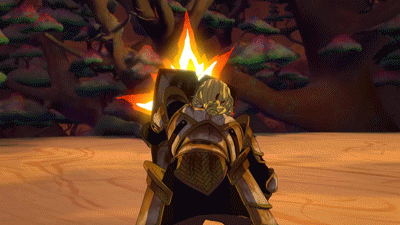
These parallelisms lead us to two considerations:
The two weddings are inversions: this isn't any news because in RWBY the second wedding is always an inversion of the first. Still, when it comes to White Knight, this inversion is particularly through and it ties with an important motif of theirs. Weiss and Jaune are strong mirrors of each other.
Cinder and the Cat (our two antagonistic Mercurius) force Jaune and Weiss into specific gender roles. Both mock Jaune (the knight) and use Weiss (the damsel). This isn't by accident and it ties with the archetype explored by White Knight, aka that of the Anima/Animus.
MIRROR MIRROR = ANIMA + ANIMUS
Weiss and Jaune's weddings mirror each other in multiple ways. Let's see how.
Weiss and Jaune's first wedding starts with Cinder impaling Weiss and leaving her to die. Jaune rushes by her side and activates his semblance to save her. The whole scene ties in their respective fairy tale symbolism. As a matter of fact Jaune performs a miracle as Jeanne. Weiss instead gets resurrected by the Prince and crowns herself Queen Snowhite through the Queen Lancer.
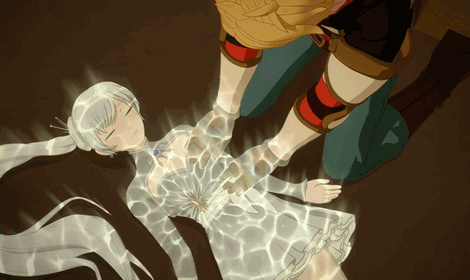

Weiss and Jaune's second wedding starts at the end of volume 8, when Cinder defeats them both and reiterates their trauma. She forces Jaune to kill a maiden and targets Weiss to hurt Winter. She is also the reason why Weiss and Jaune end up together in the Ever After, where their wedding reaches its climax. In this magical world, Weiss guides Jaune towards self-realization and metaphorically has him fall, so that he can integrate Alyx and resurrect. Their interaction in volume 9 references another alchemical text, knowns as the Splendor Solis. Specifically, it alludes to this plate:

This plate has:
2 miners excavating a hill (a metaphor for making the stone from the prima materia). It is important that the two characters wear respectively a golden and a silver robe, which call back to the Sun and Moon
The Sun and Moon mirroring each other. The Sun is in the sky (air) and the Moon is in the river (water). They are opposites balancing each other
Eshter's story pictured in the frame of the pedestal. Eshter is a biblical character and the second wife of King Ahasuerus, who is determined to kill the Jews. Still, Eshter (a Jews herself) steps in, touches the King's staff and convinces him to let her people live
The plate's theme is the beginning (prima materia) of a union (sun and moon) through communication (Eshter's parable).
It is referenced here:
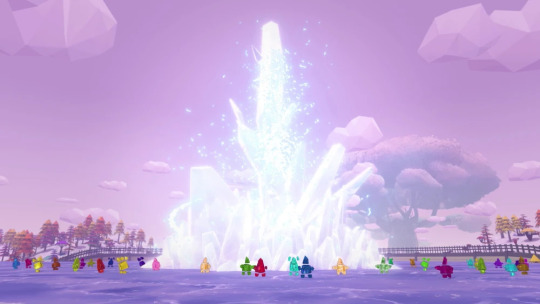
The Genial Gems create a giant white hill, which clearly alludes to the philosopher stone. Jaune and Weiss play the Solar King and the Lunar Queen:
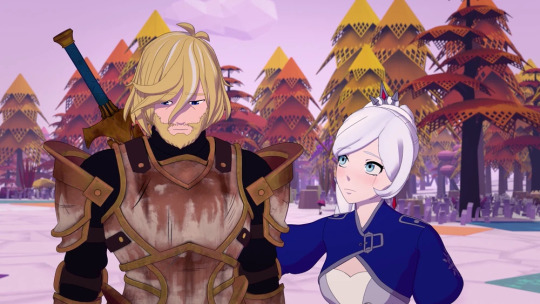
Jaune is linked to the sun and masculine (gold), while Weiss to the moon and feminine (silver). They grow closer thanks to empathy.
In particular, their interaction is an inversion of King Ahasuerus and Eshter's. In the biblical episode, the King wants to kill the Jews and Eshter stops him. In RWBY, Jaune doesn't want to let the Paper Pleasers ascend and Weiss tries to get through to him (together with BY):
Weiss: Then why do you care so much about this village?! Jaune: Because I can actually PROTECT these people!!
Just like Esther touches the King's staff, Weiss grabs Jaune's sword:
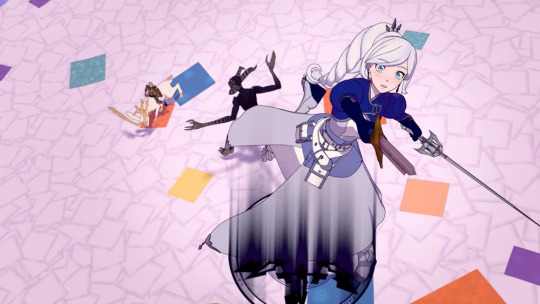
Eshter's gesture is a symbol of intimacy and connection. Similarly, using another person's weapon in RWBY shows closeness.
In short, both weddings are rich of symbolism, but the first focuses on the fairy tale allusion, whereas the second explores alchemical imagery. This isn't the only difference, though, as the two situations are perfect parallels/inversions of each other:
In Mistral, Cinder kills Weiss to hurt Jaune, whereas in Atlas, she forces Jaune to kill Penny. Moreover, both times she negates Weiss's agency and uses her as a pawn to hurt someone else (Jaune and Winter).
In Mistral, Jaune and Weiss go through a crisis together, but they emerge victorious. In Atlas/Ever After, Jaune and Weiss lose, but grow closer as they come to terms with this defeat.
In Mistral, Jaune hurts Weiss because of his psychological issues, but saves her physically. In the Ever After, Weiss saves Jaune psychologically, but hurts him physically. Both are responsible for the death and resurrection of the other.
In Mistral Jaune unlocks his semblance (changes spiritually), whereas in the Ever After he becomes young again (changes physically). Both in Mistral and in the Ever After Weiss ends the wedding by unlocking a new summon. She conjures the Queen Lancer in Mistral and the Nevermore in the Ever After.
In Mistral, Jaune is led by Pyrrha towards his ideal-self, whereas in the Ever After, he is led by Weiss towards his real-self. Symbolically, he goes through two stages of the anima integration. From Pyrrha/Mary (devotion and idealism) to Weiss/Sophia (understanding and reality).
In Mistral, the resurrected Weiss unlocks her Queen Lancer, which is key to fighting Hazel. In the Ever After, Jaune integrates Alyx and is reborn after a trial of fire. Once he comes back, he is key in defeating Neo and the Cat with his plan to separate them. Both do not "win" the conflict, but are instrumental to its solution (Weiss through heart and Jaune through mind).
In general, both times Jaune and Weiss make important steps to integrate their anima/animus, which their bond represents. The anima/animus is the feminine (anima) and the masculine (animus).
In Mistral:
Weiss integrates her animus and summons a Queen Lancer, an entity which is both queen (feminine) and knight (masculine)
Jaune integrates his anima (feminine) by discovering himself a healer (traditionally feminine quality)
In the Ever After:
Weiss integrates her animus by acting as Jaune's Knight. She summons her Knight while fighting side by side with him. Moreover, throughout the whole volume Weiss looks for someone who can guide her home. It turns out in the climax she herself is the guide, the knight, who leads Jaune and the others to the tree. As a matter of fact she is the one who teaches the others the theme of "acceptance".

Jaune integrates his anima by accepting he is no hero (no Knight) and by realizing Alyx is a part of himself. He faces her and integrates her spiritually (her vision in the smoke) and physically (her knife):

In volume 9, both Weiss and Jaune regress and go back to their stereotypical selves. Weiss is stuck as the damsel and Jaune rusts as the knight. However, they move on thanks to each other. They are reborn.
WHITE KNIGHT= REBIRTH
The focus of White Knight is rebirth (coagula). In Mistral they get a victory and in Atlas they get a loss. Still, both weddings climaxes in resurrections. Weiss is reborn in volume 5 and Jaune is reborn in volume 9. Not only that, but after White Knight's Ever After wedding Ruby herself is reborn:

This renewal of the self is celebrated by a full Nevermore:

This marks White Knight's second wedding as their nevermore wedding, which has them overcome grief through love.
NEVERMORE
Weiss summons her full Nevermore in the finale. This Grimm is tied to both Ruby and Jaune.
It is symbolic of Ruby's rebirth, as it is the first Grimm team RWBY killed together and Ruby landed the final blow. Weiss is able to manifest it because by the end her team is whole again and Ruby is back.
It celebrates Jaune and Weiss's wedding, as our Lunar Queen conjures it after her interaction with Jaune. Their exchange is the pivotal moment for Weiss in volume 9, as she helps herself by helping Jaune. She teaches Jaune to forgive himself and learns to forgive herself at the same time. As a result, she unlocks this summoning, which is symbolic of the self:

Its glyph is in fact a mix of all the other ones, as Weiss is a sum of all her avatars.
Jaune too makes a decisive step towards the self:
Alyx: Maybe it’s time for a change, to be the kind of man you always wanted to be.
He accepts Alyx and gets a second chance to grow up as a result:
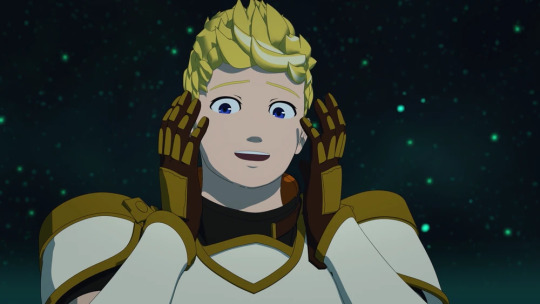
His new self has a white streak of hair to show he has successfully integrated with Weiss (white) and has obtained wisdom.
FROM UNCONSCIOUS TO CONSCIOUS
There is one final difference between White Knight's two weddings. The first has Weiss and Jaune's metaphorical union happen unconsciously. The second instead has this process become conscious. Let's consider this:
In Mistral Jaune instinctively activates his semblance and Weiss unconsciously unlocks her summon. Their actions happen because of internal and unconscious changes that are not elaborated on. They are quick transformations and the wedding itself is quick.
In the Ever After Weiss consciously encourages Jaune. By doing so both characters find a catharsis for their unconscious feelings. They make them conscious. Similarly, Jaune can consciously face Alyx and integrate with her. Weiss's own summoning is not quick and raw, but it is the result of a process that starts in volume 8 (when she fails to materialize the Grimm), goes on in the chess fight (she has the wings appear) and is finally complete at the end of volume 9 (the full Nevermore manifests itself). The wedding is also very slow and distributed throughout two volumes.
This choice makes sense, as Weiss and Jaune's dynamic is about them slowly realize who they are and who the other is. They have been each other's mirrors since the beginning and as they better understand themselves, they can better relate to the other and accept them.
#rwby#rwby chemical weddings#chemical weddings#white knight#weiss schnee#jaune arc#rwby meta#rwby alchemy
41 notes
·
View notes
Text
Syzygy, or Animus and Anima: Weiss and Jaune
Anima-Animus anon, here is your meta. I genuinely do think Weiss and Jaune are one of the best literary examples I've seen of animus and anima, respectively. This is not inherently a shipping meta, although you could read it that way.
Of note: I did talk about Jaune and anima before here in a larger meta about his arc, and about Weiss and animus here. But I want to talk about their arcs because they are complimentary, and really encapsulate how to write anima and animus pretty perfectly.
So let's go over it. What is anima? What is animus? How is Jaune one of Weiss's animuses? How is Weiss one of Jaune's anima? And what does this mean thematically for their arcs and the work of RWBY as a whole?
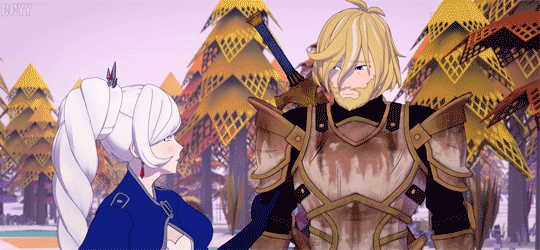
Jungian Archetypes
I have a whole meta on Jungian archetypes in RWBY. But I just want to quickly go over some of them because I'll use these terms in the meta.
Persona: the part of ourself we present to the public. It's usually somewhat fake, or at least societally acceptable.
Shadow: the part ourselves we repress because we do not want to acknowledge the parts of us that are selfish, hurting, weak. End goal: integration with the shadow and accepting that these are parts of you. In literature, the shadow is often negative or antagonistic if embodied in a character, because facing it requires facing character flaws. However, only by integrating with the shadow do we start to heal. It's necessary to become a complete person. Associated with the Black stage in alchemy, and with Blake.
Anima/animus: the feminine/masculine within ourselves. This can overlap with the shadow in some ways (for example, men often don't want to admit that they're weak). Anima/animus can be positive and negative. Associated with the White stage in alchemy, and with Weiss and Jaune. You don't have to interpret it as romantic, but it often is.
Self: The Self is the end goal of Jungian psychology: achieving individuation, or the fullness of being who you are and knowing your role in the world. Associated with the Red stage in alchemy, and with Ruby.
Syzygy: the union of anima and animus.
Lastly, I want to disclaimer about the terms "masculine" and "feminine" here. Jung was writing at a time when gender binaries and roles were very much a thing. Of course they apply less today (and RWBY deliberately plays with some of these, as we'll see). But when I use the term "masculine" or "feminine" in this meta I mean in the traditional sense Jung is talking about. Masculine=bravery, physical power, fear of the weak. Feminine=beauty, emotions, kindness, etc. Please note this is clearly oversimplified and I am not endorsing this, just explaining a pattern that Jung pointed out in regards to literature.
Jaune and Anima
Between anima and animus, anima is more likely to be romantic in fiction. That's because Jung associated anima with something he called Eros (Greek for romantic/sexual love). A man's anima is also almost always one person at a time. This is not the case with animus, as we'll see.
Hence, the two women associated with Jaune's anima are Weiss and Pyrrha.
The previous meta I did on Jaune's arc makes a strong argument that Pyrrha firstly embodies his anima. She almost perfectly goes through the first three of four stages of anima in regards to how Jaune views her, which are:
Eve (mother)
Helen (romantic interest)
Mary (religious devotion)
Sophia (wisdom, guide to the inner life)
I would also argue that Pyrrha embodies Sophia too here, but the living Sophia is also Weiss. Sophia is Greek for "wisdom," and both the official RWBY Twitter account and the show itself make the connection explicit for us, with the Curious Cat calling Weiss "wise Huntress."
But it's also deeper than just stages here. Jaune's entire arc is about the rejection of toxic masculinity and the embrace of his own role as maiden. Only through becoming a Maiden (in other words, embracing the feminine within) can he become a Knight (the man he was meant to be).
Jaune As The Maid of Orleans
Jaune's allusion is, of course, Jeanne d'Arc. He has a feminine allusion, which tells us to expect his integration with the inner feminine. Joan of Arc was also know as three things:
A spiritual guide to France in wartime
A soldier/knight
A maiden
In real life, Joan of Arc was dismissed because she was just a girl... until she started actually winning battles and her predictions came true. God or not, there's something really powerful and intriguing and eerie about her story. Joan of Arc referred to herself as "Jeanne la Pucelle," or "Joan the Maiden."
But what is a Maiden? In Joan's time, it literally meant "virginity," because there was a prophecy that France would be restored by a virgin. In other words, her virginity was a strength--spiritually, at the time period, her going to war with men yet maintaining her virginity was seen as a sign of righteousness (yes, it was very anti-sex).
In RWBY, a maiden is also hardly a weakness. No, a Maiden is a specific type of power.
It's also associated with martyrdom.
Jaune has had special relationships with several of the Maidens in the series: firstly, Pyrrha, who chooses to kiss him (a nice pro-sex commentary honestly) before dying as a Maiden even though the power had not been transferred to her. Pyrrha ends up a martyr like Joan of Arc, but her legacy, like Joan's lives on. Pyrrha embodies what Jaune should become.

Penny, of course, dies as a martyr too. She is stabbed by Cinder and there isn't time to save her. Jaune, who defines himself as a healer thanks to his semblance, has no choice but to kill her so that Penny stays in control of her destiny. It's tragic, but like Pyrrha, it isn't empty.
Of course, Cinder has now killed Jaune's first love interest, tried to kill another (Weiss), and then made Jaune into a killer via stabbing Penny. Hence, Jaune and Cinder are also linked, and the message of what a maiden should be, and what destiny is--the message Pyrrha carried, the message of choice embodying destiny that Penny carried--is something I suspect Jaune will give to Cinder before the end.
Still, all of these incidents, the three big alchemical deaths of the series--Black Death, White Death, and Yellow Death (Crocea Mors)--involve Jaune and specifically switch the gender of what you would expect from a hero.
The Knight is supposed to protect the Maiden. Instead, the Maiden kisses Jaune and locks him away to save him while she fights Cinder. Jaune is supposed to protect the Maiden, but she (Weiss) gets impaled precisely because he couldn't get over his previous failure to save Pyrrha. This time, though, he saves Weiss.
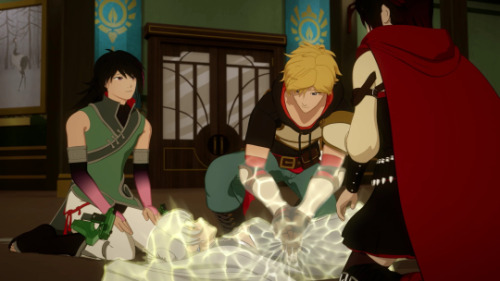
The thing is, though, that healing is traditionally a feminine attribute. Hence, Weiss lives and Jaune heals because, symbolically, of his ability to embrace the inner feminine.
Lastly, the Knight is supposed to save the Maiden. But instead, saving the Maiden looks like becoming the monster himself, like becoming his shadow (which Cinder is). It shatters his sense of self, as we've been seeing throughout Volume 9.
If a Knight is also a dragon killing a maiden, who is he?
Jaune As The Rusted Knight
Jaune's sword is broken, and he intensely clings to this persona of "knight who saves" the entire volume. But by intensively insisting on saving the Paper Pleasers, he doesn't realize he's repeating what Ironwood et al did to Penny: refusing to allow them their own right to choose their destiny. He also fails to save Alyx.
Jaune's "knight who saves" persona has been a key part of his character since the first season. He cheats to get into Beacon because he wants to be a hero and carry on his family's legacy. He's embarrassed to be so weak, but the only way to become strong is to rely on women. Team RWBY, Pyrrha, even Nora and Ren (who don't fit gender stereotypes themselves).
Pyrrha literally trains Jaune. Notably, whenever Jaune relies on male advice, he fails. In fact, his knight persona is precisely why Weiss doesn't like him at first (not just romantically; like, at all.)
Weiss: (separating the two) Jaune, is it? Do you have any idea who you're talking to?
Jaune: Not in the slightest, snow angel.
Jaune: I don't understand. My dad said all women look for is confidence! Where did I go wrong? (accepts Ruby's offered hand and uses her to lift himself back up)
Yang: "Snow Angel" probably wasn't the best start.
Jaune's confidence and understanding of women coming from his dad instead of like, actual women, means he's going to make an arse of himself. And he does. At first.
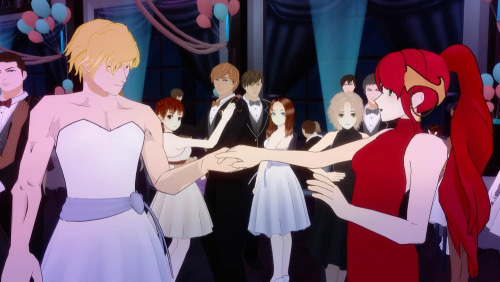
But, Jaune starts to integrate with the feminine through not just Pyrrha training him physically, but also through doing things like dressing up as a princess and going to the dance like that to honor his word to Pyrrha. He gets closer to Weiss by talking to Neptune about feelings rather than by impressing her through feats of strength. He then saves her life via delving into a traditionally feminine power. And in the end of Volume 9, he is restored to his young self via Alyx, the girl he thought he couldn't save.
Weiss and Animus
Oh boy, animus.
Okay, so... Jung did not write nearly as much about animus as he did about anima. Supposedly that's because he's a dude and recognized that he could not actually experience animus. Fortunately, his wife Emma wrote a lot about it, as did some direct colleagues (like Marie-Louise von Franz) who specifically applied animus to its portrayal in fairy tales.
Animus differs from anima in a few key ways. The centrality of the concept--that it's the masculine within a woman--remains the same. However, animus:
is not usually limited to just one person at a time like anima;
doesn't follow stages nearly so neatly (they exist but are a bit... debatable)
is not inherently based on Eros, or a romantic understanding. No, instead animus is based on Logos.
What is Logos? Logos is literally "word" in Greek, but the actual usage is more akin to "mind" or "spirit." Weiss, of course, is a mind character. It can also refer to the principle of the matter. In other words, a woman looks for her masculine traits in a principle she holds dear.
Jung himself said:
The male personification of the unconscious in the woman — the animus — exhibits both good and bad aspects, as does the anima in man. But the animus does not so often appear in the form of an erotic fantasy or mood [as the anima often does to men]…even in
a woman who is outwardly very feminine the animus can be an equally hard and inexorable power. One may suddenly find oneself up against something in a woman that is obstinate, cold and completely inaccessible.
Weiss as Princess Snow White

Weiss starts off possessed by her negative animus, the Logos or principle.
What is animus/anima possession? It's specifically a negative manifestation of the animus (or anima) wherein someone behaves overwhelmingly like their masculine side--but in a negative sense. In other words, for Weiss, this looks like a persona of toxic masculinity.
Possession caused by the anima or animus presents a different picture... The animus is obstinate, harping on principles, laying down the law, dogmatic, world-reforming, theoretic, word-mongering, argumentative, and domineering.
I kinda do think this sounds like early-volume Weiss. But it also sounds like... Jacques Schnee.
See, the animus is also often a reflection of a woman's father. Even though Weiss is determined to prove herself without her father's influence by the start of the series, we also see that she is in some ways behaving like him. Of course she's not nearly so ruthless or bigoted, but she does maintain some prejudice about faunus, maintains entitlement (demanding to be leader of RWBY), tells off Ruby for accidents, etc. She's denying her femininity.
But then her development starts, and with this, her animus changes. Who are her animus?
Well, as I said above, animus has multiple presentations, and for Weiss they're specifically unique... because some of them are women. Make of that what you will, shippers and headcanoners. I'm not just going off of nowhere in saying that I think some of Weiss's masculine animuses are women, either; I'm specifically talking about it in regards to Weiss's allusion of Snow White.
You can find numerous fairy tale analyses with animus/anima interpretations. Snow White is one of the most obvious ones. But Weiss's Snow White is genderbent... mostly. Except for her.
See, in the Grimm version of the fairy tale, Snow White's father is alive. He just does absolutely nothing to stop his wife from abusing Snow White. In this story, Willow, Weiss's mother, is the absent one, doing absolutely nothing to stop Jacques from abusing her children. As a result, we have the Shadow develop--in the fairy tale, the Shadow is the Evil Queen. In Weiss's story, it's Jacques. He is who she doesn't want to be, but does have similarities to especially in her persona.
Snow White then meets nine other men. Yes, there are a total of ten male characters, and they are all aspects of animus. In the original Snow White fairy tale (reference this analysis), we can break it down as such:
Absentee dad
Huntsman
Seven Dwarves
Prince
In this, we can see slow progression of Snow White's integration with her masculine side.
Firstly, it's denied to her (she's completely out of balance) because her father refuses to take any action and is never mentioned again.
Secondly, the Huntsman takes action and spares Snow White from the queen, but also doesn't exactly help her. He sends her off into a dangerous forest to fend for herself.

Thirdly, we see reciprocity finally appear. Snow White helps the dwarves, but they also help her. It becomes a mutual relationship in which she learns from all seven of them.
Lastly, Snow White is revived thanks to the prince, who marries her as an equal.
When we compare this to Weiss's arc, we see similarities. Willow is absent, denying her what she needs. Then, Winter play the role of the Huntsman, helping Weiss forge her own way to a degree but still leaving her to rely on herself when she could maybe use a bit more help.
Thirdly, Weiss meets RBYJNPR: her seven dwarves. She learns how to be herself, learns who she is, in great part because of them.
Lastly, this volume we have her developing an attraction to Jaune, whom she knows and who has revived her. She gets to be fully Prince and Princess.
What About Stages?

The stages of animus, when they exist, are loosely defined (as in Jung himself didn't actually say this, but is often attributed as having said it) as:
Tarzan: physical power
Byron: man of action or romance
Lloyd George: man as a professor or orator
Hermes/Mercury: man as a spiritual guide
If we look at this through the lens of Weiss's arc, we do see traces of these. The physical power Weiss is attracted to is embodied in Winter and Pyrrha. I mean Weiss specifically calls out Pyrrha's physical strength when she meets her:
Weiss: So, Pyrrha, have you given any thought to whose team you'd like to be on? I'm sure everyone must be eager to unite with such a strong, well-known individual such as yourself!
Weiss: This will be perfect! The smartest girl in class combined with the strongest girl in class! Together we will be unstoppable! I can see it now! We'll be popular! We'll be celebrities! We'll get perfect grades! Nothing can come between us now!
The man of action/romance is embodied in the Rusted Knight persona, and in Neptune, who is notably a giant flirt.
As a professor or orator, I would actually say there are many here. Klein, of course, reminding her who she is. Then there is Robyn, who is probably the most obvious orator in the story. Also Ironwood. Basically, thanks to Robyn having the election stolen from her, Weiss helps take down her dad. As a result, her mother returns to her (the feminine returning) and she is able to get Whitley to help save them all (integrating the masculine).
We also see a little bit of this later on with Jaune, in that Weiss expressly says she admires his maturity.
The technique of coming to terms with the animus is the same in principle as in the case of the anima; only here the woman must learn to criticize and hold her opinions at a distance; not in order to repress them, but, by investigating their origins, to penetrate more deeply into the background, where she will then discover the primordial images, just as the man does in his dealings with the anima.
We're not quite there with Hermes/Mercury, and I would bet that Jaune won't fully become gold or a spiritual guide unless he, well, has something to do with saving Mercury Black. The allusion is too literal not to be used.
Weiss as Knight
Weiss has always been a knight in addition to being Snow White, a maiden princess. Weiss defeats a knight-like creature (Arma Gigas) in the White trailer, and then goes on to be able to summon Arma Gigas as part of her semblance thereafter.
She's exceptionally talented in combat. In fact, the person Jaune calls to save Pyrrha when she's gone to fight Cinder is Weiss. He begs her to save Pyrrha, and Weiss promises him she will.
Sadly, just like Jaune in his attempts to be a knight, she can't, but not for lack of trying.
Later, in Volume 5, we see Weiss receive a power up that comes from her soul (another word for anima). The knight imagery becomes even more part of her semblance, as @aspoonofsugar has written. Notably, she summons Queen Lancer (literally referring to both the maiden-princess and knight archetype) after Jaune heals her in Volume 5. In other words, it's part of her integration with Jaune.

Then, Volume 8 happens, and Jaune again tries to rely on Weiss. He insists to Penny that "Weiss will buy us time" to heal Penny. And she would have tried (and probably died). But Penny tells Jaune that he's the one she needs to do something brave. It's his time to be a knight.
Weiss similarly expresses confidence that Jaune would have done the best he could after she arrives at the Ever After, unaware that he's fallen, too. Even as they go through the Ever After, Weiss affirms her Logos: herself, which is defined by her heroism and her failures.
Weiss: I don't know who you think you are, but let me tell you who I am. I am the granddaughter of a hero and the child of a villain. I am a citizen of a fallen kingdom and an heir to nothing. I will not be defined by my name because I will b e the one to define it. I am Weiss Schnee, and I am a Huntress.
And then we have the finale of Volume 9. Here, Weiss is the one to give Jaune words of wisdom, to encourage him after the Paper Pleasers return as jewels and Jaune realizes that he was not only holding them back, but holding himself back (literally, Jaune, despite being older, has not grown at all emotionally; he's stagnated. He's not a 40 year old in a teen's body; he was a teen in a 40 year old's body). Weiss tells Jaune what she told her younger self:
Jaune: I wanted the rush of rescuing someone, and I got that here.
Weiss: I think you're asking too much of yourself. We've been telling ourselves that failing means we're no good. But I can guarantee even the best Huntsmen in history? They've all lost. But they were still incredibly brave. And good.
In response to this, Jaune starts to cry (a traditionally feminine trait!), and Weiss asserts again what her Logos is: being a knight and a maiden, being brave and good, even when that means you can't save everyone.
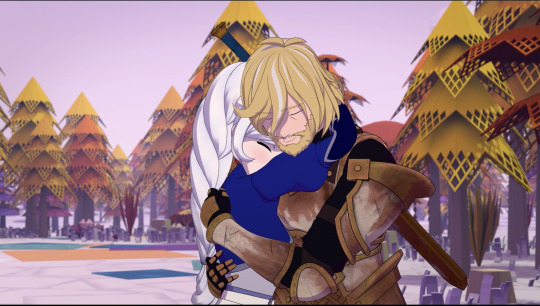
So then they fight together, again.
But it's another reversal. The princess, instead of being saved by the knight, almost kills the knight with fire in a scene that comments on what happened with Pyrrha, Jaune saving Weiss, and Penny.
Integration of Knight and Maiden
What's interesting about the Pyrrha-anima-animus connection is that it is Weiss who introduces Jaune to Pyrrha in the first place. Weiss wants to be Pyrrha's partner, actually. She deeply admires Pyrrha, as shown as she says about her and Pyrrha in that first meeting:
Nothing can come between us now!
What immediately comes between them is Jaune. Literally.

But it's not Jaune coming between them in an icky two girls can't get along because of a boy love triangle way. No, instead it's the three of them united because of their relationships with each other.
In that same scene, the very first, we have Weiss literally asking Pyrrha to intervene and get Jaune away from her by throwing her spear... which she does. The symbolism of Weiss asking Pyrrha to throw her spear into Jaune is uh. It's Freudian. Let's leave it there.
In fact, Jaune's feelings for Pyrrha start to develop as a result of her training him physically and encouraging him about his crush on Weiss. Hence, Weiss has been a part of Jaune and Pyrrha's relationship since the start of it; all three of them have an inextricably intertwined relationship.
Then, when Pyrrha says goodbye to Jaune and kisses him, it's right before shoving Jaune into a locker, the same as the ones she met him in front of. This time, when Jaune's in trouble, he calls Weiss--understanding that he needs someone else to save Pyrrha, and trusting that Weiss can do it. Jaune calls Weiss, because she's a knight. Unfortunately, she can't save her.
In Volume 5, Jaune saves Weiss precisely because his grief over Pyrrha contributes to Cinder impaling Weiss. Pyrrha is central to Weiss and Jaune's bond. Pyrrha and Weiss have always been intertwined as Jaune's anima, and if they do end up going with romantic White Knight, they would never have happened if it weren't for Arkos.
While I often see early-volume!Jaune's feelings for Weiss dismissed as shallow, I don't think they actually are. I think they're immature, sure, but look at what he tells Ren about Weiss:
It's Weiss... I'm completely head over heels for her, and she won't even give me a chance. She's cold, but she's also incredible. She's smart, and graceful, and talented-- I mean have you heard her sing? I just wish she take me seriously, y'know? I wish I could tell her how I feel without messing it all up.
Jaune clearly always did see the actual Weiss, not just her beauty, physical strength, or name. Yes, he was initially attracted to her persona, but the undercurrent was always real. Even Snow Angel.
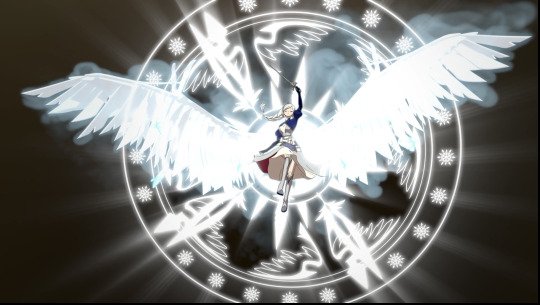
The problem is that Jaune could never be with Weiss if he remained in his Knight persona, expecting her to take the princess role. No, instead, they both have to be knight and princess.
Knight and maiden have never been more clearly integrated than in Volume 9's portrayal of Weiss and Jaune. Jaune is the legendary "Rusted Knight." But, he turns out to still be a Maiden literally waiting around a tower/house for rescue in the form of Team RWBY.

When the Jabberwalker comes, Jaune and Weiss fight together just like Bumbleby fight together; this is explicitly paralleled. (Also, Weiss kind of ignores her fighting partner, Ruby, which contributes to Ruby's feeling lonely; this isn't inherently wrong because they like, needed to stop the Jabberwalker, but it still, well, is, and is also emblematic of Ruby feeling left behind).
During this fight, Jaune tosses his sword to Weiss, who expertly wields it despite it being broken and then gives it back, therefore symbolizing that Weiss can be the knight, that she can be the masculine one, and letting her do so is actually not emasculating for Jaune. Instead, it's realization of his potential in being both knight and maiden.

(And, let's not get into the very very basic Freudian symbolism 101 of a woman using a man's sword.)
The Maiden, instead of being saved by the knight, almost kills the knight with a baptism of fire.

In fact, in Jung's own writing on the philosophical tree (yes, really), he notes this:
The lapis signifies the inner man... the natura abscondita which the alchemists sought to set free. In this sense the Aurora consurgens says that through baptism by fire "man, who before was dead, is made a living soul."
...
The genuineness or in-corruptibility of the stone is proved by the torment of fire and cannot be attained without it. This leitmotiv runs all through alchemy.
What is funny here is that Jung uses "lapis" here to mean the philosophical stone, which is most commonly called a ruby. But it can be a sapphire, or apparently a lapis lazuli. Go google the color lapis and tell me that that is not exactly Weiss's dress color.
Like Joan of Arc, Jaune is consumed by the fire. He is coagulated after the dissolution of the Paper Pleasers. But instead of coming forth as ashes, he comes forth as gold... with some growth still ahead and with some white streaks in his hair, symbolizing integration with the feminine (white=feminine in alchemy and Jung).
So where do Weiss and Jaune go from here? Jung provides a clue:
“Just as the anima becomes, through integration, the Eros of consciousness, so the animus becomes a Logos; and in the same way that the anima gives relationship and relatedness to a man’s consciousness, so the animus gives to a woman’s consciousness a capacity for reflection, deliberation and self-knowledge.”
C.W. Vol 9. Part II: Aion. The Syzygy: Anima and Animus
Both Jaune and Weiss have done this for one another thus far, and will continue doing so. Neither Weiss's nor Jaune's arcs are entirely over, either: Jaune still needs to fully embody the spiritual guide, and Weiss needs to embody wisdom and they are both so close but still have a bit more to grow.
#anima#animus#rwby meta#white knight#weiss schnee#jaune arc#pyrrha nikos#arkos#jung#alchemy#a bit#rwby#rwby volume 9
105 notes
·
View notes
Text

Some shading and highlighting practice.
REBLOGS ARE BETTER THAN LIKES
DO NOT REPOST
20 notes
·
View notes
Text
okay
let's talk about alchemical readings and rwby.
as the resident crank it would be remiss of me not to begin this little jaunt with a very important disclaimer: like all esoteric lenses, alchemical philosophy is an analytical framework that relies quite heavily on symbolism, and because of that it is really important to be mindful of how you're engaging with the text. symbolism services narrative, not the other way around, and you should always let the narrative guide your understanding of its symbolism. if that doesn't make sense to you, don't worry, because there will be lots of examples to illustrate what i mean.
before getting into the weeds, we're going to lay out some basic alchemical concepts.
in simple terms, the core philosophical idea of alchemy is a gradual process of transformation from base material into the sublime; conceptually the transmutation of lead into gold is also the perfection of human body and soul. alchemy is about change, refinement, rebirth, wholeness.
the prima materia—first matter—is the perfect and formless primordial matter of which all forms of matter are derived. if you're familiar with certain other alchemical readings of rwby you'll have seen it defined as the "raw material" that is transformed into the philosopher's stone through the alchemical process; that is not inaccurate but it must be stressed that the idea here is that ordinary matter comes from the prima materia and the philosopher's stone IS the prima materia, made perfect and whole again through the great work.
<- rwby directly invokes this idea in 'all things must die' ("all bonds dissolve/infinite matter/will always evolve").
yliaster is another name (coined by paracelsus) for the prima materia, which he described as "completely healed human being who has burned away all the dross of his lower being and is free to fly as the phoenix."
the great work is the actual process of alchemy. it is classically broken down into four (or three) stages, each represented by a color:
nigredo, black, involves putrefaction and charring—symbolically, death. decay. rot.
albedo, white, involves purification and separation. the undifferentiated mass of the nigredo stage is clarified and divided into two opposing principles.
citrinitas, yellow, is the "dawn" or reawakening.
rubedo, red, involves coagulation and recombination after the separation undergone in albedo.
citrinitas is not always treated as a discrete stage, instead sometimes being combined into a single stage with rubedo or understood as the transition between albedo and rubedo. hence "four (or three)." there are also a great variety of other stages, mostly given in sets of seven or twelve and listed in myriad sequences, but for our purpose this four-or three-stage model is the most useful.
now!
ordinarily with an alchemical reading, we would begin by finding a narrative pattern of symbolic death and rebirth, but for rwby we first need to interrogate the goliath in the room, namely:
YES, IT'S ABOUT SALEM.
there is a tendency in alchemical readings of rwby to interpret salem's immortality as a lifeless unchanging stasis, and thus to read her as an embodiment of the anti-theme, and surprising absolutely no one i find this to be… well, just not right at all.
rwby initially sets up the pattern through the mantra pyrrha recites when she awakens jaune's aura: "for it is in passing that we achieve immortality. through this we become a paragon of virtue and glory to rise above all, infinite in distance and unbound by death. i release your soul, and by my shoulder protect thee." 'rising' explicitly calls back to this ("we are paragons of virtue and glory/death can't bind our endless story/infinite and unbound") and 'indomitable' reiterates the idea ("when we strive, we transcend/even death cannot end our climb"); this is important to note because the repetition correlates with revelations about salem's story.
the key thing to understand here is that 'the lost fable' is narratively structured around salem's deaths:
first, the god of light bites her and she's drowned in the fountain of life (notice her last breath leaving her mouth; she chokes for air and her eyes rolls back as she loses consciousness, sinking into the depths)…



…and then the god of darkness brings the moon down on her head and she wanders in a haze until finding her way back to the pool of grimm, where she seeks her own destruction and is created anew.
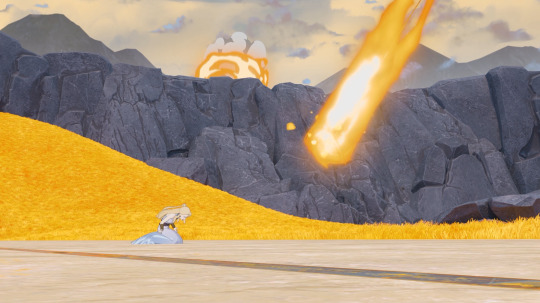
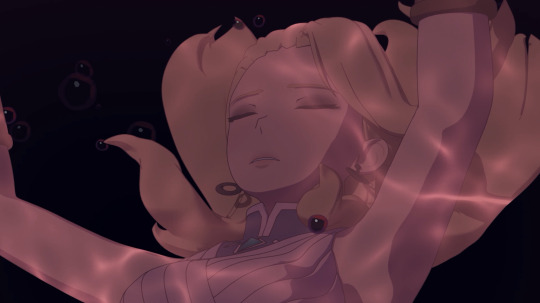

the brothers cast salem into the fountain of life, which pools under the roots of a tree and appears to be infinitely deep. she drowns as she sinks into its darkness—then abruptly reawakens hitting the water again, now only a reflecting pool, and the water-light of aura shimmers over her hands as she rises.
"for it is in passing that we achieve immortality…" the reprisal of "infinite and unbound" in 'rising' draws a line from pyrrha's mantra to the lost fable for a reason; it's to help us understand the truth behind the story jinn is telling. it is not even subtext—it is text. especially after volume nine, which clarifies the symbolic meaning of the tree growing above the waters.
through death, salem became immortal—infinite—and the infinite waters of life and creation became finite.
that water was the prima materia of the brothers' world; it combined with salem—the prima materia changes itself and combined with all imperfect bodies that it touches—and thus she herself became yliaster, "the perfectly healed human being who has burned away all the dross of his lower being and is free to fly as the phoenix."
the dross in her case being the brothers and their divine order, she rebels against them, and they destroy their world. she is all that remains. they leave salem behind in the end of all things and, phoenix-like, she rises out of the ashes of her destruction. yliaster is the prima materia; it contains everything, is everything, and everything is released when it is broken apart.
"this force of pure destruction could not destroy a being of infinite life, so it created a being of infinite life with a desire for pure destruction." destruction exists within creation exists within destruction: salem embraces death, throwing herself into the "blackened pools of annihilation" in the land of darkness. nigredo.
she's torn apart and reborn, and remnant is born with her, a pure-white being clambering into a revitalized new world she cannot touch; after a long separation, her partner returns to her and she experiences love, connection, freedom for the first time in years, until she learns that he seeks the destruction of this world and a return to the old and they burn each other alive in a violent parting. albedo.
salem's arrival in atlas literally at dawn incites the struggle between herself and cinder, which culminates in salem beginning to relinquish control and as her true feelings come to the surface. citrinitas.
thus, what remains of her story is rubedo: reconciliation with cinder, reunion with ozma, peace between humans and grimm (<- unity of opposites), and finally symbolic transcendence over death by convincing the god of light to ascend, with "death" being specifically the threat of annihilation represented by the divine mandate.
ozma's arc, of course, mirrors hers very closely: the god of light breaks him apart, the god of darkness burns him (nigredo)—his reincarnation divides him very literally into two, and symbolically divides him between duty and desire (albedo)—he awakens with the dawn, reconciles with oscar, and begins to face the truth in atlas (citrinitas).
as alchemical readings go, this one is not difficult or arcane or remotely ambiguous. it isn't even symbolic; the deaths and resurrection are explicitly literal and occur onscreen with the accompaniment of helpful explanatory notes. the goliath in the room is making aggressive eye contact.
but we are not done here yet, because i never do anything by halves and we have symbolism to talk about.
THE GREAT WORK.
salem, you will recall, is yliaster, the prima materia of remnant. you will also recall that the prima materia is the formless primordial matter from which all other matter is formed, and thus it is both the raw material of the great work and the philosopher's stone. yes? good. rwby interrogates this contradiction through the idea of balance, which the god of light conceives of as an inviolate order that must be designed and enforced. but, as the blacksmith explains, his understanding is a limited falsehood:
"balance is not two forces locked in never-ending battle. balance is an ecosystem, an organism, a living, breathing thing; thus balance cannot be restored by force or calculation. it only requires love and the patience to see things through to the end."
here is where i think a lot of the fandom—not people doing alchemical readings necessarily, but in general—miss the mark by interpreting this to mean that opposition and balance are antithetical to each other, that a system with two opposing forces is inherently out of balance. rwby's metaphysics are grounded in hellenistic philosophy, plato in particular (<- neoplatonism had a significant influence on the western european alchemical tradition), and the philosophical ideas undergirding the ever after follows herclitus.
(i recommend perusing the category pages for λόγος, justice and strife, the harmony of opposites, φύσις, ψυχή, cosmology, fire, water/the river, life/death, and waking/sleeping—i know that sounds like a lot of reading, but it isn't, as what we have of heraclitus is only fragments and the summaries provided are brief and accessible.)
the two key ideas we're interested in here are flux and strife. the world exists at rest in a continual state of change; a river is always the same river, but its flowing waters change from moment to moment. this conception of the world—"changing, it rests"—is flux. strife incites change through the tension between opposing forces. strife is not discordant but rather harmonious: "men do not know how what is at variance agrees with itself. it is an attunement of opposite tensions, like that of the bow and the lyre." (B51) just as a bow could not fire and a lyre could not sing without tension on the strings, so the world could not be without strife.
this is what the blacksmith means by balance. true balance is not war; it is strife. not two forces locked in never-ending conflict, but opposite tensions in harmony with each other. destruction and creation are opposing forces, but each exists within the other and they are both interdependent and inseparable.
salem embodies this theme. through death, she became life, and by destruction she was created. human and grimm, light and darkness, creation and destruction. she seeks to tear down the huntsmen academies and incite revolution in pursuit of a new world. she is balance—and the god of light inflicted his punishment upon her not because she failed to understand the importance of life and death, but because her dedication to change challenged his false and hollow conception of what balance means.
this guides the alchemical reading of the wider narrative in significant ways. salem is the prima materia of remnant—yliaster, broken apart to release everything contained within—and thus both the subject and the aspiration of the great work. when we examine other characters through this lens, it is in relation to her.
we'll begin by discussing the narrative's big symbols: the rose, the broken moon, the tree, grimm, silver eyes, and fire.
traditionally, the rose symbolizes rubedo. in most alchemical readings of rwby, ruby rose is accordingly presumed to represent this stage for obvious reasons—however, if we pay attention to how the narrative itself symbolically identifies the rose:
ruby's emblem, which she inherited from her mother, is a burning rose.
our first sighting of it is on summer rose's grave, above an epitaph—"thus kindly i scatter"—taken from a poem which uses the death of a rose as a metaphor for the speaker's loneliness and despair.
"red like roses fills my dreams and brings me to the place you rest," and "red like roses fills my head with dreams and finds me always closer to the emptiness and sadness that has come to take the place of you"
adam's emblem is a withered rose.
"the moon will sadly watch the roses die"
"maybe red's like roses? maybe it's the pool of blood the innocents will lay in when in the end you fail to save them"
"the rose will grow to be a seed, from every life another leads" (<- evokes an image of deterioration, rot; the rose going to seed)
"some roses will never bloom, some dreams will rot on the vine"
in rwby, the rose represents death. it burns, it withers, it dies, it is scattered, it never blooms; thus, it does not symbolize rubedo but rather the death and decomposition of nigredo. why then is ruby's primary color red? we'll get to that in a little while.
the moon traditionally symbolizes albedo, which is a process of separation, reflection, and illumination. the god of darkness shattered the moon as he departed after slaughtering humanity, and:
"the moon will sadly watch the roses die"
"the sky is turning black, light is fading fast, but we don't surrender; shattering the night, radiant and bright, armored in splendor, shining forever […] we're rising like the moon"
salem falls into and through the reflection of the broken moon when she casts herself into the pool of grimm
the broken moon symbolizes the death and resurrection of humankind, which—as noted—is the beginning of the albedo stage in salem's story.
so in rwby the broken moon does indeed represent albedo.
the tree, obviously, represents the whole circle of life-death-rebirth, with its symbolic meaning on remnant following its actual function in the ever after, where it is the cosmic tree, the river, and the ever-living fire. thus cinder and salem falling into pools of water at the base of a tree are symbolic (and in salem's case, also literal) rebirths.
grimm are "manifestations of anonymity," "the darkness," hates and feared as soulless monsters, destruction incarnate, thought to have no purpose other than to exist as "mankind's greatest foe." rwby is consistent in using the grimm to symbolize ostracism, persecution, fear of the other or the unknown, and salem's exile is justified (in ozma's mind) by her grimmness. which is to say, the grimm represent the separation undergone during albedo; they are the darkness to humanity's light. (hence, the narrative building toward coexistence between humans and grimm, exemplified by the faunus.)
silver eyes are described in opposition to the grimm and likewise represent the separation of albedo; the light to grimmkind's darkness. salem's experimentation with combining them into one being is a faunus for good reason, and i do not think it is coincidental that cinder has become less vulnerable to the glare as she finds balance with the grimm arm. and speaking of her:
the phoenix is another traditional symbol for rubedo, which naturally calls to mind associations with fire. citrinitas, similarly, is represented by the dawn or the "solar light," overtaking the moonlight of albedo, which again connotes fire. in rwby, fire is used to symbolize hope and wrath, which are thematically intertwined (hope ignites fire -> loss of hope incites wrath -> wrath ignites fire, and is thus a form of hope):
"even the smallest spark of hope is enough to ignite change […] nature's wrath in hand, man lit their way through the darkness"
"a simple spark can ignite hope, breathe fire into the hearts of the weary…" becoming "i can't wait to watch you burn"—salem seeks to smother ozma's hope, and thus rekindle her own.
"the light of hope is taken and discontent is the contagion; the blinding eyes that burn a yellow flame, the embers that remain will light the fuse of condemnation"
"we were destined to light the flame of revolution; consider this the spark" + "i think father may have just provided the spark that's going to set this kingdom on fire"
flame imagery used in relation to cinder and salem in the volume eight opening and jaune throughout volume nine.
cinder being… a spark…
as i noted, the paradigm shift between salem and cinder in atlas represents the transition from albedo to rubedo through the dawn. in rwby, the kindling spark symbolizes citrinitas and the changing flame that follows is rubedo. the role cinder will play in reigniting salem's hope is obvious, and the symbolic use of fire to reawaken first jaune and then neo in volume nine only underscores this meaning. in combination with the dust and ashes motif going on with salem and the grimm, the fire becomes specifically phoenix imagery.
now!
why, if the rose is nigredo, is ruby red?
in order to explain this, we first need to examine team STRQ, because the answer is that the great work is cyclical.
in team STRQ, we have:
summer rose, whose red-and-gold interior is masked by her white exterior
taiyang xiao long, who is all yellow
raven branwen, who is an amalgam of red and black
qrow branwen, who is mostly white except for his red cape
the branwen twins also transform into corvids, traditional symbols for the nigredo stage; qrow's scythe harbinger and raven's allusions to the morrígan underscore their symbolic association with death.
if we consider these color associations through an alchemical lens, the pattern that emerges is—by design—muddled and strange, but not actually that convoluted:
raven "tried to leave," but couldn't. she became the spring maiden by mercy-killing a girl whom she loved as her own family, and never having dealt with that grief or guilt, is trapped in nigredo whilst projecting a hollow image of rubedo—her pretense of strength. she runs away from her feelings, rather than challenging or examining them; what she needs instead is to separate and reflect honestly on herself.
summer did leave. her white outer shell—the phantom she left behind—suggests albedo, but her true colors are what she wears beneath the cloak: red trimmed with gold. she found salem, listened to her and awoke to the truth of this world, and then joined her. but in order to do that, she had to separate from her own family, joining salem exile; thus her individual rubedo brings her into alignment with the grimm in salem's albedo.
qrow, shattered by the dissolution of his team, is undergoing his own albedo. like his sister, he wears the trappings of rubedo—he is the one left standing, ozpin's most trusted agent—but this is a false projection which crumbles once it challenged by the revelations of ozma's deceit. his drinking and reluctance to be around people for fear of bringing them to harm make it impossible for him to move forward until he finds new hope and decides to try again. like his onetime mentor, he experiences citrinitas in atlas and the beginning of his transition into rubedo is marked by the introduction of maroon (desaturated red) and tan (desaturated yellow) into his atlas fit.
tai, lastly, is interesting because in one sense, he is citrinitas in isolation, a dawn with nothing to illuminate because his team left him behind, but in another sense, tai mediates the generational transition between team STRQ (albedo) and team RWBY (rubedo). he is yang and ruby's father and—crucially—he raises both in idealized casts of their mothers. ruby feels compelled to live up to the fairytale idea of summer rose; tai tells yang that he sees all of raven's good qualities in her and warns her to be wary of being too much like her mother, in almost the same breath.
ruby's red and yang's yellow represent the culmination of what tai wishes could have been; the summer rose who returned whole and alive, the raven branwen who chose reflection and reawakening instead of running away. but both colors are only things projected onto them—false images.
in truth, ruby represents nigredo. her scythe and the burning rose both connect her to death; her semblance disassembles her into a swirling formless mass of rose petals; her own identity is lost beneath the idea of summer rose and the first nine volumes of the story are devoted to the long, slow journey to her symbolic death at the roots of the tree.
only with her ascension has she begun to undergo albedo (notice the greater emphasis on her silver eyes and the flaring white light as she comes out of the tree; also, "otherside, did you mean to leave me half or whole? will i ever be complete? when will i become all of me?" and "what is left? i know it's you and i when i look inside"—she is beginning to separate herself from the imaginary paragon.
weiss represents albedo—her story is fundamentally about separation from her family, leading to self-reflection and growth, and in the process she has become an emotionally intelligent, insightful person who consistently helps others draw out and clarify their hidden emotions. her mirror motif and her knight summon further represent this: the self and the reflection.
blake represents citrinitas—her golden eyes, her association with the black king, her identity as a faunus, all support this reading. her time with the white fang was her albedo (she lost herself, gradually began to see herself in a new light, and finally separated herself from everything adam represented) and her personal moment of citrinitas is the removal of the bow and meeting with sun after she reveals herself as a faunus, after which she begins her journey of rediscovering herself and reintegrating with her faunus heritage.
finally, yang represents rubedo—her fire, her red eyes, "scathing eyes ask that we be symmetrical, one-sided and easily processed, yet every misshapen spark's unseen beauty is greater than its would-be judgment," "feel like i'm finally unbroken, feel like i'm back from the dead," the whole thematic conceit of bumbleby being the catalyst and the flame, the dawn and the sun, and so forth, two-in-one, "we're protecting each other."
the team collectively represents rubedo in relation to salem, in that they will be the ones primarily negotiating with her and this will obviously not begin to happen until ruby has her personal moment of citrinitas, which is to say not until ruby meets the real summer rose.
as a final point of interest, the four qualities (and relics) of destruction, creation, knowledge, choice map neatly onto the four-or-three alchemical stages—destruction as nigredo, creation as albedo, knowledge-then-choice as citrinitas-then-rubedo—and given the parallelism between yang and cinder, blake and raven, and weiss and penny+winter, it is probably a safe bet that the summer maiden is a) not summer rose, and b) a character foil to ruby, which i think adds some weight to the gillian theory.
anyways.
the philosopher's stone is ozlem.
#to be clear i think the alchemy thing is more convergent evolution from plato than deliberate use of alchemical structure#but neoplatonism did significantly influence western european alchemical philosophy so there is a lot to work with#and putting it in alchemical terms can be a clarifying analytical shorthand#as long as you don't. ignore everything the narrative spells out wrt salem#ANYWAY. HERE. TAKE IT.
30 notes
·
View notes
Text
Thinks about.
Self Aware AU(?)
Ozpin and Oscar centric lol (also maybe Qrow and Ruby are there too but like, later on???)
In terms of “Oscar and Ozpin know they’re not Real™️ and that nobody else is Real™️ either”
And every Oz incarnation has this happen where they know there are higher beings out there watching them.
I just think it’s funky.
So like, once Oscar becomes the next incarnation, he probably becomes self aware like Oz was.
Leave me alone I just think it’s funky
12 notes
·
View notes